Introduction
Market infrastructures, together with markets and institutions, constitute one of the three core components of the financial system. The market infrastructure for payments[1] consists of the set of instruments, networks, rules, procedures and institutions that ensure the circulation of money. Its purpose is to facilitate transactions between economic agents and to support efficient resource allocation in the economy.
The Eurosystem has the statutory task of promoting the smooth operation of payment systems. This is crucial for a sound currency, the conduct of monetary policy, market functioning and financial stability. A key instrument which the Eurosystem uses for carrying out this task is the provision of payment settlement facilities.[2]
To this end, in 1999 the Eurosystem created the Trans-European Automated Real-time Gross settlement Express Transfer system[3] (TARGET) for the settlement of large-value payments in euro, offering a central bank payment service across national borders in the European Union (EU).
TARGET was developed to meet three main objectives:
- provide a safe and reliable mechanism for the settlement of euro payments on a real-time gross settlement (RTGS) basis;
- increase the efficiency of inter-Member State payments within the euro area;
- serve the needs of the Eurosystem’s monetary policy.
In May 2008 TARGET2 replaced the first-generation system, TARGET. Like its predecessor, TARGET2 was used to settle payments connected with monetary policy operations, as well as interbank payments, customer payments exchanged between banks, and transactions related to other payment and securities settlement systems, i.e. ancillary systems. As TARGET2 provided intraday finality, meaning that settlement was final for the receiving participant once the funds had been credited, it was possible to reuse these funds several times a day.
From June 2015 TARGET2 participants were able to open dedicated cash accounts (DCAs) on the TARGET2-Securities (T2S) platform[4], which they could use to settle the cash leg of their securities transactions. In addition, from November 2018 TARGET2 participants were able to open DCAs for TARGET Instant Payment Settlement (TIPS).[5] TIPS is the service implemented by the Eurosystem for settling euro-denominated instant payments on an individual basis, around the clock.
TARGET2 offered harmonised market infrastructure services at EU level, as well as a single pricing structure. It provided ancillary systems with a harmonised set of cash settlement services and supported its users with enhanced liquidity management tools. In this manner, it contributed to financial integration, financial stability and liquidity efficiency in the euro area.
TARGET2 was accessible to a large number of participants. Approximately 1,000 credit institutions in Europe used it to make payments on their own behalf, on behalf of other (indirect) participants or on their customers’ behalf. Taking branches and subsidiaries into account, over 41,000 banks worldwide (and all of the customers of these banks too) could be reached via TARGET2.
Building on the synergies between the two market infrastructures, the Eurosystem worked intensively to consolidate TARGET2 and T2S services. The project brought technical as well as functional enhancements. This allowed changing market requirements to be met by replacing TARGET2 with a new RTGS system called T2 and liquidity management to be optimised across all TARGET services. The new RTGS system provides the market with enhanced and modernised services which will also be available for currencies other than the euro. The messaging standard has migrated to ISO 20022, as for T2S and TIPS. In addition, the project further strengthened cyber resilience capabilities and established a single point of access to all Eurosystem market infrastructure services. It supports multi-vendor connectivity, allowing participants to choose between different connectivity options and fostering competition among network service providers. The new system went live on 20 March 2023.
The report and its structure
This report is the 23rd edition of the TARGET Annual Report. The first edition was published in 2001, covering TARGET’s first two years of operation (1999 and 2000). As in previous years, the report provides information on TARGET2 traffic, its performance and the main developments that took place in 2022. It is aimed mainly at decision-makers, practitioners and academics who need to have an in-depth understanding of TARGET2. We hope it will also appeal to members of the general public with an interest in market infrastructure issues and, in particular, TARGET2.
In addition to the core content, this report includes seven boxes on topics of particular relevance in 2022. The boxes focus, respectively, on the evolution of turnover and volume in TARGET2; TIPS volume development and functional evolution; the impact of Russia’s invasion of Ukraine on TARGET2; the impact of the ECB’s monetary policy decisions on the money market rates derived from TARGET2; enhancements to the TARGET services communication tools; TARGET2 analytics for regulatory compliance; and an update on the TARGET2/T2S consolidation project and future RTGS services.
In the report, references made to the first-generation TARGET system (which was in operation from January 1999 to May 2008) are also applicable to its second generation, TARGET2 (which replaced TARGET in May 2008).
Note
Liquidity transfers between TARGET2 and T2S/TIPS DCAs and payments processed on T2S/TIPS DCAs are not included in the TARGET2 indicators presented in this report.
Although both T2S and TIPS DCAs are legally part of TARGET2, these (technical) transactions are excluded from the calculations to prevent the system’s indicators from being artificially inflated and to make the figures more easily comparable from year to year. Nevertheless, as a matter of transparency, some general statistics on T2S and TIPS DCAs are provided on the ECB’s website.[6]
TARGET2 activity
In 2022 TARGET2 maintained its leading position in Europe, processing 92% of the total value settled by large-value payment systems in euro. It also remained one of the largest payment systems worldwide. Compared with the previous year, the total turnover processed increased by 17.8%, reaching €570.5 trillion.[7] The total volume of payments grew by 6.5% to 102.6 million transactions.
The highest daily turnover during the year was recorded on 21 December, with a total value of €3,481 billion, and the highest daily volume of payments was recorded on 19 April, when 622,003 transactions were processed. This was the highest peak since the launch of TARGET2.
In 2022 the availability of TARGET2’s Single Shared Platform (SSP) stood at 100%.
1 Evolution of TARGET2
Table 1
Evolution of TARGET2 traffic

Note: There were 257 operating days in 2022 and 258 operating days in 2021.
1.1 TARGET2 turnover
TARGET2 turnover in 2022 amounted to €570.5 trillion, corresponding to a daily average of €2.2 trillion. Chart 1 shows the evolution of the value of TARGET2 traffic over the last nine years. TARGET2 turnover on RTGS accounts fell by almost 15% between 2015 and 2017, following the launch of T2S.[8] In 2018 the TARGET2 turnover stabilised, and in 2019, 2020 and 2021 it recorded annual increases of 2.0%, 5.6% and 3.9% respectively. In 2022 TARGET2 turnover increased by 17.8% (see Box 1). These increases in turnover stemmed mainly from payments relating to operations with the central bank and from interbank payments.
Chart 1
TARGET2 turnover
(left-hand scale: EUR billions; right-hand scale: percentages)
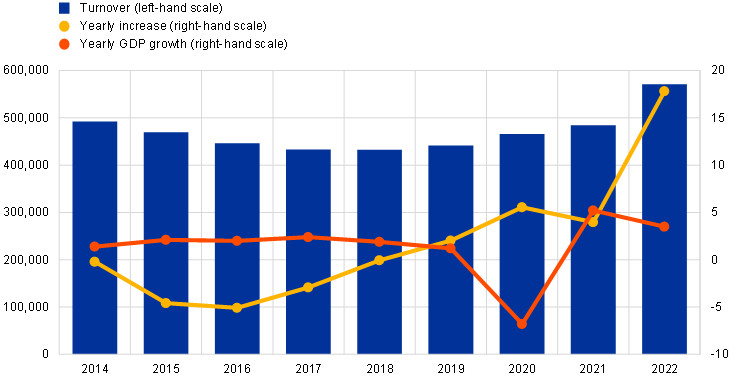
Source: TARGET2.
For activities involving market participants (i.e. excluding central bank and ancillary system transactions), interbank transactions (transactions exclusively involving credit institutions) accounted for 72% of the total value of payments in 2022, while the remaining share was composed of customer transactions (i.e. transactions processed on behalf of a non-bank party, be they individuals or corporate customers). This share has remained stable over the past few years (75% of interbank payments in 2021).
A comparison of the TARGET2 turnover and the euro area’s annual GDP (around €13 trillion) shows that the system settled the equivalent of annual GDP in six days of operations. This reflects the role and efficiency of TARGET2, which provided intraday finality for transactions and allowed the funds credited to the participant’s account to become immediately available for other payments. Consequently, the same euro could be reused several times by several participants in the same day.
Chart 2 depicts the average daily turnover generated in TARGET2 for each month in 2021 and 2022, thus showing the seasonal pattern of the system. While the general pattern for both years is very similar, the values recorded in 2022 are higher than they were in the same periods of 2021, especially from the third quarter onwards, as ECB policy rates increased. More details can be found in Box 5.
Chart 2
Average daily TARGET2 turnover
(EUR billions)
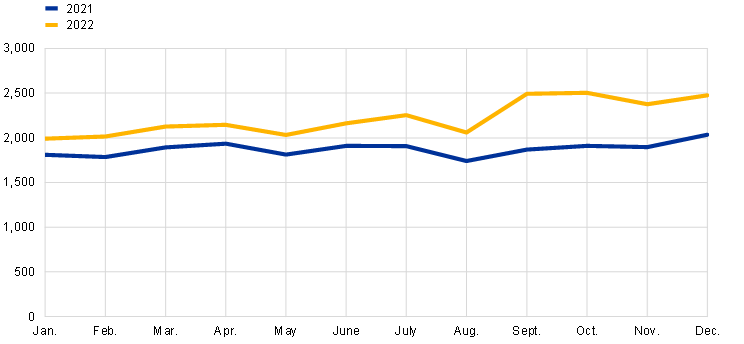
Source: TARGET2.
Chart 3 displays the highest and lowest daily TARGET2 values for each month of 2022, as well as the average daily values. The days with the highest peaks are usually at quarter-ends, typically on the last day of the month, owing to reimbursements and due dates in various financial markets. This seasonal pattern was also visible in 2022. However, the day with the largest turnover of the year, with a total value of €3,480 billion, was 21 December. This is largely due to the combination of end-of-month, end-of-quarter and end-of-year effects traditionally observed around Christmas time.
Chart 3
Monthly peaks, troughs and averages of TARGET2 daily values in 2022
(EUR billions)

Source: TARGET2.
Throughout 2022 the amplitude of TARGET2 turnover, expressed as the difference between the highest and the lowest values, was 54%, compared with 51% the previous year. Overall, the average values throughout the year followed a well-established seasonal pattern.
Peaks and troughs in the system’s values can also be influenced by other factors, such as TARGET2 holidays or the end of reserve maintenance periods. For example, the lowest values are typically recorded during the summer holidays and on days that are national holidays in some Member States or in other significant economies outside the EU. In 2022, for instance, the lowest values processed coincided with a public holiday in the United States (Presidents’ Day on 21 February).
Finally, Chart 4 compares traffic developments in the world’s major payment systems. In particular, it depicts the daily average turnover in euro equivalents for the last nine years of TARGET/TARGET2, Continuous Linked Settlement (CLS), Fedwire Funds (the US dollar-denominated RTGS system operated by the Federal Reserve System) and the Bank of Japan Financial Network System (BOJ-NET). Some common patterns can be identified across systems. However, the comparability of TARGET2 with other systems has been hampered by the migration of the securities settlement systems to T2S.[9] If the average daily volume in TARGET2 after 2015 is considered together with the average daily turnover for DCAs, which are technically held in T2S, total traffic continued to increase.[10]
Chart 4
Major large-value payment systems around the globe
(EUR billions)
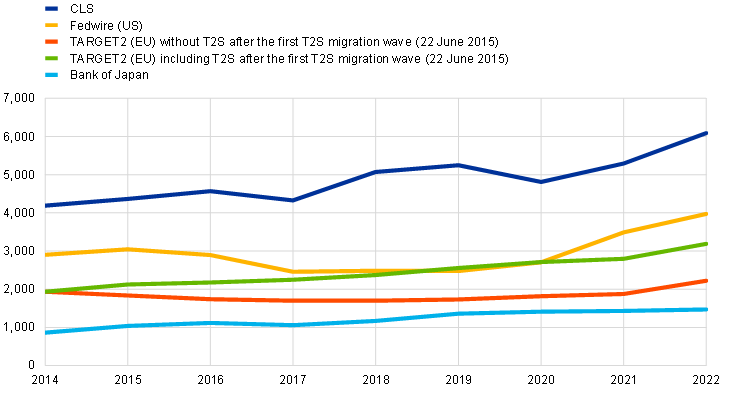
Sources: TARGET2, Fedwire Funds Service (website of the Federal Reserve System); BOJ Time-Series Data (Bank of Japan website); ECB data.
Box 1
The evolution of TARGET2 turnover in 2022
Besides monitoring the number of payments settled in TARGET2, the Eurosystem also regularly looked at the evolution of TARGET2 turnover over time. This analysis intensified last year in the light of technical changes and monetary policy decisions that affected the value of payments exchanged in TARGET2. This box presents the insights gained from analysis of the 2022 turnover.
Interbank payments accounted for 51.1% of total TARGET2 traffic in terms of value, followed by central bank operations (19.7%), ancillary system payments (18.0%) and customer payments (11.2%) (see Chart A). Ancillary system payments turnover showed the greatest year-on-year increase, amounting to 30.75%. This was primarily driven by higher payment values settled in Germany (+21.45%) and in ECB accounts (+66.19%), and is mainly linked to the fact that STEP2-CGS switched to a pre-funded settlement model, and to the related funding and defunding activity. Customer payments turnover increased by 29.23% compared with 2021. This was in excess of volume growth and confirms once more that customer payments have not yet suffered from the uptake of instant payments in Europe. The increase was driven primarily by higher turnover in the Netherlands (+46.0%), France (+30.1%) and Germany (+27.99%). The value of interbank payments increased by 10.76% year on year, mainly driven by the growth in France (+16.9%), Germany (+9.5%) and the Netherlands (+9.3%). Central bank operations turnover was 21.70% higher compared with 2021. This increase is mainly attributable to growth in Germany (+69.45%), where the number of intra group liquidity transfers aimed at facilitating use of the deposit facility spiked once ECB policy rates had returned to positive territory.
Chart A
TARGET2 breakdown of turnover and yearly growth rate by payment type in 2022
(left panel: number of transactions, trillions: right panel; percentages)
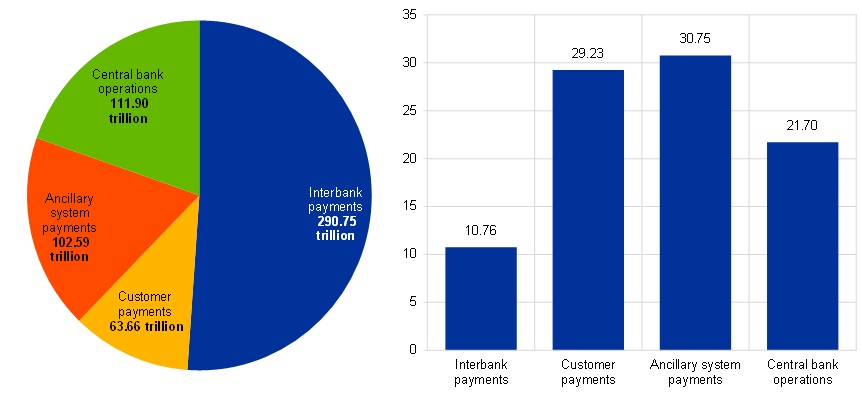
Source: TARGET2, ECB calculations.
Note: there were 258 operating days in 2021 and 257 operating days in 2022.
Overall, between €21.43 trillion and €26.85 trillion of interbank payments were settled each month (see Chart B). These displayed the typical seasonal pattern, decreasing in January and February, around April and May and in August, while increasing mostly at quarter-ends. Customer payments turnover ranged from €4.23 trillion to €6.10 trillion per month and was affected by a similar seasonal trend as interbank payments, although less pronounced. Ancillary system payments turnover increased from a monthly average of €7.38 trillion in the first half of the year to €9.72 trillion in the second half, which was mainly due to STEP2-CGS going live. The value of central bank operations similarly increased from a monthly average of €8.30 trillion before the 75 basis point rate hike in September to €11.38 trillion afterwards.
Chart B
TARGET2 monthly turnover by payment type in 2022
(turnover in trillions)

Source: TARGET2, ECB calculations.
Note: there were 258 operating days in 2021 and 257 operating days in 2022.
Year-on-year growth in overall TARGET2 daily average turnover increased throughout the year, peaking in September, when ECB policy rates went back into positive territory (see Chart C). The September spike was observed in all segments, especially interbank payments and central bank operations. After some fluctuation in the first eight months, central bank operations value registered +33.58% growth in September and peaked at +55.13% in December. Interbank payments growth, on the other hand, showed a more moderate increase until August, peaked in September (+20.98%) and then increased at a slightly lower pace of between +10% and +20%. Ancillary system payments showed a steady increase in growth from the beginning of the year until September, when year-on-year rate peaked at 67.5%. The most notable increases took place between July and September, after STEP2-CGS had gone live. Overall turnover in TARGET2 in 2022 experienced a strong increase compared with 2021. The Eurosystem will continue monitoring traffic developments throughout 2023, especially in view of the migration to the consolidated T2-T2S platform.
Chart C
Year-on-year change in daily average TARGET2 turnover in 2022
(percentages)
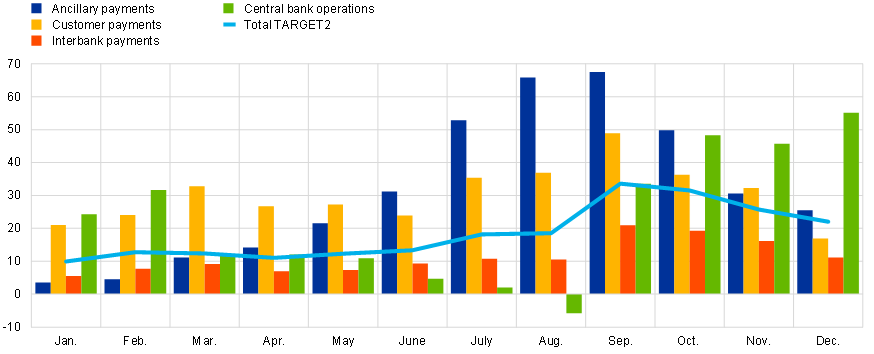
Source: TARGET2, ECB calculations.
Note: there were 258 operating days in 2021 and 257 operating days in 2022. Total TARGET2 turnover includes ancillary system payments, customer payments, interbank payments and central bank operations.
1.2 Volume of transactions in TARGET2
After the low transaction volumes resulting from the financial crisis, TARGET2 traffic recovered, posting a positive trend between 2010 and 2013 (Chart 5). Although the number of transactions never reached pre-crisis levels, the system attracted around four million transactions more over that period. However, this trend reversed in 2014 and 2015 because after the period for migration to Single Euro Payment Area (SEPA) instruments ended[11], there was once again a significant reduction in the customer payment segment, leading to lower TARGET2 volumes. On completion of the migration to SEPA, TARGET2 traffic stabilised at around 88 million transactions yearly. In 2022 the number of transactions increased significantly to more than 102 million.[12] This represents a historical peak since the launch of TARGET2 in 2008, and actually even since the creation of the euro in 1999.
Chart 5
TARGET2 traffic
(left-hand scale: number of transactions in millions; right-hand scale: percentages)

Source: TARGET2.
The exact volume settled in TARGET2 in 2022 amounted to 102,597,758 transactions, corresponding to a daily average of 399,213 payments. Compared with the previous year, the overall number of processed payments grew by 6.5%, driven by a higher number of interbank and customer payments. More detailed information on the evolution of the different traffic segments is provided in Box 1.
Throughout the whole year average daily volumes in TARGET2 calculated on a monthly basis were above the levels recorded for the corresponding months in 2021 (Chart 6). The biggest year-on-year difference, amounting to 11%, was observed in February and this trend continued for the rest of the year. Overall, Chart 6 indicates a seasonal pattern similar to that of the previous year.
Chart 6
Average daily TARGET2 volumes per month
(number of transactions)

Source: TARGET2.
The highest average daily volume was recorded in December, when it reached more than 430,000 transactions. This figure may be related to the high daily volumes normally observed at the end of the year.
Chart 7
Monthly peaks, troughs and averages of TARGET2 daily volumes in 2022
(number of transactions)
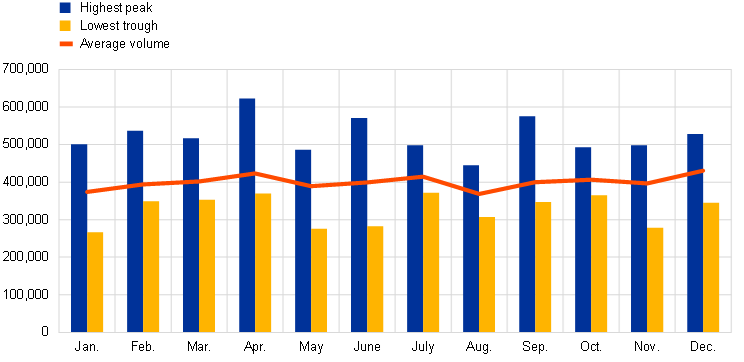
Source: TARGET2.
Chart 7 depicts the peaks and troughs in terms of the daily volume on RTGS accounts in TARGET2 in 2022 and the average daily volume for each month. As observed for the value-based figures, the peaks typically fall on the last day of the month, and are especially pronounced at quarter-ends for the same reasons (i.e. deadlines in financial markets or for corporate business). In 2022 the highest daily volume was recorded on 19 April (the day immediately following the Easter weekend, during which TARGET2 was closed for four consecutive calendar days), when 622,003 transactions were processed. This was the highest daily peak in TARGET ever (i.e. for both TARGET1 and TARGET2). The lowest daily volume was recorded on 6 January (266,252 transactions), which was a public holiday in most European countries (Epiphany).
Chart 8 shows the yearly moving average of TARGET2 volumes (i.e. the cumulative volume processed in the preceding 12 months) for each month. This indicator helps to eliminate the strong seasonal pattern observed in TARGET2 traffic. The variation of this cumulative volume from one year to the next is also presented as a percentage. The chart shows that the cumulative volume started to decline in the second half of 2008 with the onset of the financial crisis. The number of transactions continued to drop sharply almost until the end of 2009. After that TARGET2 volumes were roughly stable until the end of 2011. They then started to grow moderately until the end of the first quarter of 2014, when they reached their highest point since the crisis. Thereafter the cumulative volume started to drop for the reasons set out at the beginning of this section (SEPA migration) and in October 2014 the cumulative yearly growth rate turned negative and continued to decrease until mid-2017. The negative trend reversed in 2017 because of the increases observed in the customer and interbank payments segment. It then remained stable throughout 2018 and 2019. In 2020 TARGET2 volumes peaked temporarily in the first quarter as a result of the market turbulence driven by the COVID-19 pandemic. After recording a slight decrease in the first quarter of 2021, TARGET2 volumes rose steadily over the rest of that year and throughout 2022, to reach their highest levels since the system was launched.
Chart 8
(left-hand scale: number of transactions in millions; right-hand scale: percentages)
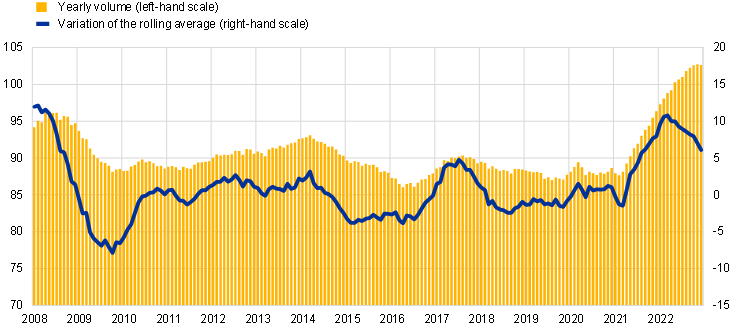
Source: TARGET2.
Chart 9 compares the growth rate (between 2021 and 2022) of traffic in TARGET2 with the growth rates of major payment systems worldwide and SWIFT payment-related FIN traffic (categories 1 and 2). The chart reveals that the changes in traffic diverged significantly across systems. The largest increase – over 6% – was recorded by TARGET2, while Fedwire Funds (the US payment system) and EURO1 decreased by 4% and 3% respectively. This shows that TARGET2 benefited from a general increase in payment activities worldwide in 2022.
Chart 9
Comparison of the changes in traffic in major large-value payment systems and SWIFT between 2021 and 2022
(percentages)

Sources: TARGET2, Fedwire Funds Service (website of the Federal Reserve System); SWIFT FIN Traffic (SWIFT website); BOJ Time-Series Data (Bank of Japan website); Key payment statistics (Bank of England website); Annual Statistics From 1970 to 2022 (the Clearing House website); SIC statistics (SIX website); and ECB data.
Box 2
The evolution of TARGET2 volume in 2022
The Eurosystem carefully monitored TARGET2 volumes over time, not least because of their relevance for revenues and cost recovery. In 2022 the focus was on the evolution of traffic after the strong growth observed following the pandemic. This box presents the insights gained from analysis of the 2022 volumes.
Customer payments accounted for 59.6% of the total TARGET2 traffic in terms of volume, followed by interbank payments (27.4%), ancillary system payments (6.9%) and central bank operations (6.1%) (see Chart A). Customer payments traffic increased by +6.1% compared with 2021, continuing the positive growth registered in the previous year, even if at a lower rate (the increase in 2021 compared with 2020 was +8.6%). This is not surprising given that the 2021 growth rate was the result of the exceptional post-pandemic recovery. The increase in 2022 was primarily driven by higher traffic in Luxembourg (+30.9%), Austria (+27.4%), France (+10.3%) and Germany (+4.3%), confirming once again that the number of customer payments has not so far suffered from the uptake of instant payments in Europe. Central bank operations showed the greatest year-on-year increase at +10.3% (the increase in 2021 was +1.6% compared with 2020). The main contributor was Germany (+12.1%), where participants increased the number of intra group liquidity transfers to facilitate use of the deposit facility once ECB policy rates had returned to positive territory. Interbank payments traffic also registered strong growth of +8.9%, although the pace was milder than 2021 (the increase in 2021 compared with 2020 was +12.7%). This trend was seen across all major banking communities, in particular in Belgium (+13.8%), France (+11.7%) and Germany (+8.5%). Ancillary system payments saw a reversal of last year’s trend (+2.6%), with a decrease of -1.8%. The drop was mainly driven by the fact that a major ancillary system, STEP2 CGS, changed to a prefunded settlement model. At country level, ancillary system traffic developments were mixed: Austria and Luxemburg showed above-average growth rates (+12.8% and +9.6% respectively) while Spain, as in the previous year, exhibited a decrease (-21.7%).
Chart A
TARGET2 breakdown of volume and yearly growth rate by payment type in 2022
(left panel: number of transactions, millions: right panel; percentages)
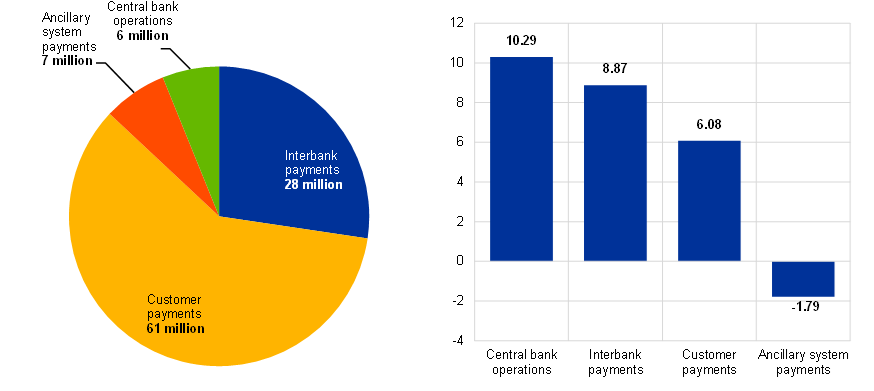
Source: TARGET2, ECB calculations.
Note: there were 258 operating days in 2021 and 257 operating days in 2022.
Overall, the positive trend observed in 2021 continued in 2022, though at a more moderate pace. Between 4.6 million and 5.4 million customer payments were settled each month (see Chart B). Customer payments behaved in line with the seasonal patterns typical of the pre-pandemic period: decreasing in January and February, around April and in August, while increasing towards the end of the year. The peak was reached in December. Interbank payments ranged from 2.2 million to 2.6 million transactions per month and followed a trend analogous to customer payments. Ancillary system payments and central bank operations, by contrast, were less impacted by seasonal effects.
Chart B
TARGET2 monthly volumes by payment type in 2022
(number of transactions in millions)
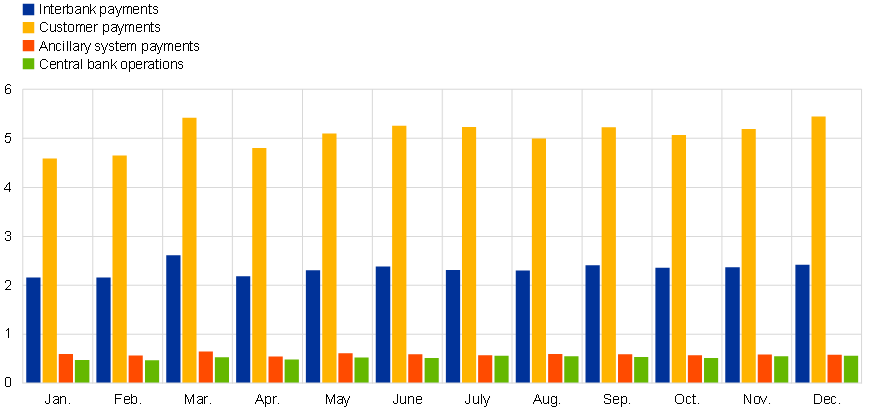
Source: TARGET2, ECB calculations.
Note: there were 258 operating days in 2021 and 257 operating days in 2022.
The steady growth path of TARGET2 traffic is particularly evident when considering the monthly year-on-year growth rate of daily average payments by category (see Chart C). With the exception of ancillary payments, all categories showed positive growth every month. Growth rates were more pronounced in the first half of the year, with customer payments increasing at an average of +7.9%, interbank payments at +11.2% and central bank operations at +15.2%; in the second they showed milder, but still steady growth (+5.6%, +7.9% and 7.6% respectively). The deceleration in the last two quarters is largely explained by the exceptional growth in the corresponding months of 2021 (the average growth in the first half of 2021 compared with the first half of 2020 was +10.4%). Ancillary system payments experienced positive growth for the first five months of the year (+3.2% on average), but this turned negative starting from June onwards (-4.4% on average). At overall TARGET2 level, in December 2022 the positive trend in year-on-year traffic growth had been continuing for 22 consecutive months. This unprecedented streak led to the settlement of over 100 million transactions in 2022, which resulted in +6.9% growth in daily average volumes compared with 2021.[13]
Chart C
Year-on-year change in daily average TARGET2 volumes in 2022
(percentages)
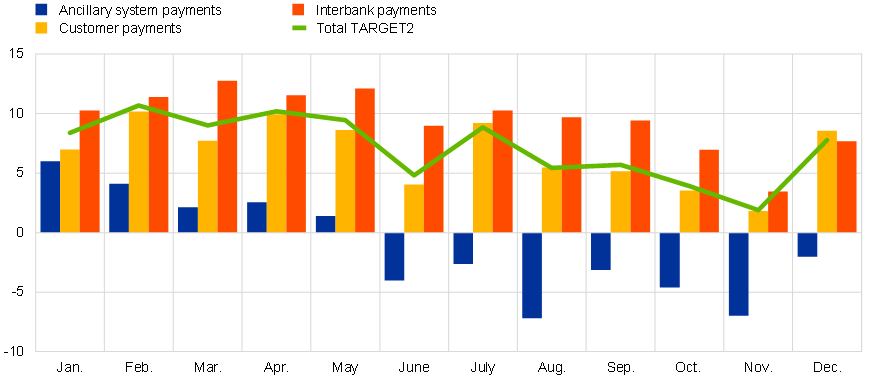
Source: TARGET2, ECB calculations.
Note: there were 258 operating days in 2021 and 257 operating days in 2022. The total TARGET2 volumes include ancillary system payments, customer payments, interbank payments and central bank operations.
Overall TARGET2 closed 2022, its last year in operations, with a positive performance compared with 2021. The Eurosystem will continue monitoring traffic developments throughout 2023, especially in view of the migration to the consolidated T2-T2S platform.
1.3 Interactions between TARGET2 and T2S
T2S is the Eurosystem’s pan-European platform for securities settlement in central bank money, bringing together both securities and cash accounts on a single technical platform.[14]
T2S went live on 22 June 2015, with central securities depositories (CSDs) joining the platform for euro settlement in waves. The final migration wave was completed on 18 September 2017, making 2022 the fifth full year of operations. In addition, on 29 October 2018 Danmarks Nationalbank connected its RTGS and collateral management system, Kronos2, to T2S, so Danish kroner can now also be used to settle the cash leg of securities transactions in T2S. On the same date VP Securities (a Danish CSD that had already been using T2S for settlement in euro) migrated its Danish krone settlement to the platform.
Although the accounts are centralised on a single platform, the legal and business relationships of the holders of the securities and cash accounts remain with the CSDs and national central banks respectively. T2S DCAs are opened with the central banks and used exclusively for the securities settlement business in T2S. Although they are technically held on the T2S platform, euro-denominated DCAs were legally part of TARGET2. Therefore the rights and obligations of T2S DCA holders were reflected in the TARGET2 Guideline. At the end of 2022 there were 828 active DCAs on the T2S platform.
At the start of each T2S business day liquidity was sent from TARGET2 to T2S. Towards the end of the day any remaining liquidity on DCAs was swept back to the RTGS accounts in TARGET2. During the day liquidity could be freely transferred from TARGET2 to T2S and vice versa.
In 2022 there were an average of 655 inbound liquidity transfers from TARGET2 to T2S and 1,145 outbound liquidity transfers from T2S to TARGET2 each day.
Chart 10 shows the average cumulative central bank liquidity held in T2S on a daily basis between January and December 2022.[15]
Chart 10
Time distribution of liquidity in DCAs
(EUR billions; daily averages)
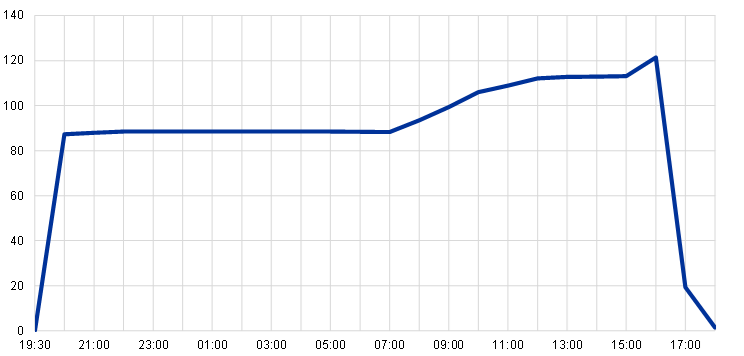
Source: TARGET2.
In terms of the intraday pattern, liquidity was injected into T2S at the beginning of the TARGET2 night-time phase (19:30 CET) and then remained fairly constant until the TARGET2 daytime processing (at 07:00 CET). After this more liquidity reached T2S and fluctuations occurred. There was a spike in the liquidity held in T2S before 16:00 CET, owing to participants sending liquidity to T2S to reimburse auto-collateralisation and ensure remaining transactions were settled. At 16:30 CET the liquidity in T2S decreased sharply as a consequence of the optional cash sweep bringing liquidity back from T2S to TARGET2. The next drop, to zero, was observed towards the end of the business day. This was related to the automated cash sweep from T2S to TARGET2 at 17:45 CET, when all remaining liquidity on DCAs was pushed from T2S back to TARGET2. The optional cash sweep was preferred to the automated cash sweep.[16]
Chart 11 illustrates the daily average value of auto-collateralisation in T2S by month in 2022. Auto-collateralisation is intraday credit granted by a euro area central bank and triggered when a T2S DCA holder has insufficient funds to settle securities transactions.
The average use of auto-collateralisation on stock, i.e. where the credit received from the central bank was collateralised by securities already held by the buyer, remained relatively stable throughout the year. The average daily value was €18.77 billion.
The average usage of auto-collateralisation on flow, i.e. settlement transactions financed via credit received from a central bank and collateralised by securities about to be purchased, was slightly more volatile and peaked at €117.39 billion in September 2022. The average daily value was €105.13 billion.
On average, 15.15% of the total value of auto-collateralisation was represented by auto-collateralisation on stock and 84.85% by auto-collateralisation on flow in 2022.
Chart 11
Daily average value of auto-collateralisation for euro and Danish krone activity
(EUR billions)

Source: T2S.
Note: Amounts settled in Danish kroner are converted into euro at an exchange rate of DKK 1 = EUR 0.13.
1.4 Interactions between TARGET2 and TIPS
TIPS is a harmonised and standardised pan-European service for the settlement of instant payments in central bank money. TIPS went live on 30 November 2018 with high capacity and 24/7/365 availability.
TIPS functionalities include the sending and receipt of instant payments, liquidity transfers and recalls of settled instant payment transactions based on the ISO 20022 standard and in accordance with the SEPA Instant Credit Transfers (SCT Inst) scheme. These instant payments are settled on TIPS DCAs held by Payment Service Providers (PSPs) with the respective national central banks.
Legally, euro-denominated TIPS DCAs were within the perimeter of TARGET2, so the rights and obligations of TIPS DCA holders were included in the TARGET2 Guideline. At the end of 2022 there were 163 active euro-denominated TIPS DCAs and 13,268 reachable parties in TIPS.
From its inception, TIPS was designed with multi-currency capability. This means that TIPS is able to provide settlement in non-euro central bank money. Based on the Currency Participation Agreement between Sveriges Riksbank and the Eurosystem signed on 3 April 2020, the connection between the Swedish RTGS system RIX and TIPS was technically established on 23 May 2022. This marked the successful completion of the first phase of the migration of the Swedish community to TIPS. The connection is essential for funding and defunding the accounts of future Swedish participants in TIPS. In the second phase the Swedish market is testing and preparing for final migration in the course of 2023, aiming to settle instant payments in Swedish kronor on the TIPS technical platform supporting the Swedish service RIX-Inst.
Work continued in 2022 in support of Danmarks Nationalbank’s plan to join TIPS, aiming to make instant payments in Danish kroner available by November 2025.
Formal discussions with Norges Bank proceeded on potentially settling instant payments in Norwegian kroner on the TIPS technical platform.
The initiative to settle instant payments across different currencies on the TIPS platform (starting with payments between the euro and the Swedish kronor) was further developed as a way of leveraging the multi-currency capability. A settlement model called the Linked Transactions Model was identified for such transactions. If the Eurosystem and Riksbank decide to take this initiative forward to the realisation phase, a pilot project will be carried out with either a restricted number of participants or an a reduced scale.
Box 3
TIPS volume development and functional evolution
TIPS settled a total of 118.8 million of instant payments in 2022, a figure approximately 17 times higher than 2021. This significant uptake was primarily driven by two factors: positive traffic developments in specific national banking communities (in particular Slovakia, the Netherlands, Italy, Germany and the Baltic region) and the migration of the European Automated Clearing Houses (ACHs) to TIPS. The growing success of TIPS is also visible in the increase in the number of parties involved, with a total of 193 participants and 13,268 reachable parties at the end of 2022.
Chart A
TIPS volumes
(number of transactions in millions)

Source: TIPS.
The majority of TIPS traffic is made up of instant payments directly settled on participants’ TIPS DCA accounts (55% in December 2022). The rest falls equally into transactions between ACHs and participants’ DCAs and transactions between two ACHs (23% each in December 2022). This is evidence of the interoperability TIPS brings to all parties.
The average value of an instant payment in TIPS is around €793. Only 15% of instant payments processed in TIPS in 2022 had a value over €1,000.
By end-March 2022 a total of 11 ACHs had moved their technical accounts from TARGET2 to TIPS and were able to offer cross-ACH transactions via the platform. The migration of ACH technical accounts was part of the measures approved by the Governing Council of the ECB in 2020. These included the obligation for all Payment Services Providers in the SCT Inst scheme reachable in TARGET2 to be reachable in TIPS, as a way of supporting the offering of instant payments across Europe. The measures will ultimately enable all European citizens to receive and send euro-denominated instant payments to and from any country in the EU.
The TIPS platform will be significantly enhanced in February 2023 with the addition of a third site to increase the overall resilience of the system.
1.5 Comparison with EURO1
EURO1 was the only direct competitor to TARGET2 among large-value payment systems denominated in euro. The market share of TARGET2 was defined as its relative share vis-à-vis EURO1, as shown in Chart 12.
The two systems were different by design, since EURO1 operates on a net settlement basis and only achieves final settlement in central bank money (in TARGET2) at the end of the day. Furthermore, they responded partly to different business cases, since only TARGET2 settled individual transactions in central bank money and processed ancillary system transactions and payments related to monetary policy operations.
However, the traffic in the two systems was made up largely of interbank and customer payments. This helps to explain, in part, the relative share of TARGET2 vis-à-vis EURO1, which is calculated on the basis of these two payment categories only. In 2022 the share of TARGET2 increased in terms of both the value and volume of payments processed, with 92% of the value and 70% of the volume settled by large-value payment systems in euro.
Chart 12 does not give a full picture of banks’ routing preferences for all systems, only partially and in relation to the settlement of large-value euro-denominated transactions. In particular, it does not reflect the extent to which payments are channelled through ACHs or correspondent banking arrangements.
Chart 12
Market share of volumes and values settled in TARGET2 vis-à-vis EURO1
(percentages)
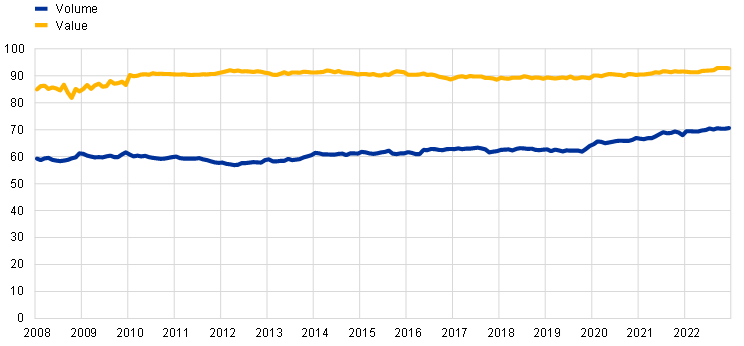
Source: TARGET/Euro LVPS (ECB website).
Note: This chart is not affected by the change in the statistical methodology implemented in 2013, since the calculations are based on interbank and customer payments only, and do not include transactions with central banks, which were most affected by the methodological change.
1.6 Value of TARGET2 payments
Chart 13 shows the evolution of the average value of a TARGET2 payment between 2014 and 2022. The continuous decrease from 2015 to 2017 was largely related to the migration of securities settlement system traffic to T2S.[17] In 2022 the average value of a payment increased to €5.5 million, from €5.0 million in 2021.
Chart 13
Average value of a TARGET2 payment
(EUR millions)
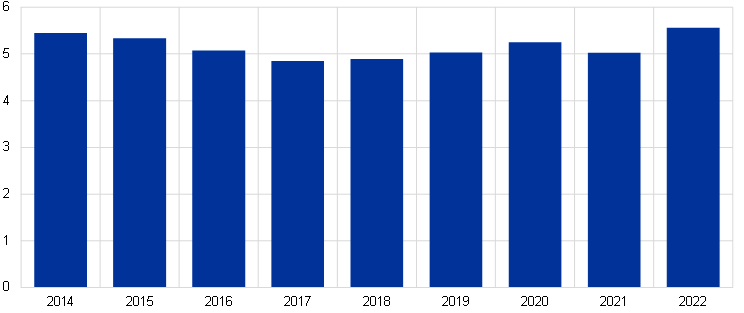
Source: TARGET2.
Chart 14 illustrates the distribution of TARGET2 transactions per value band, indicating the shares, in terms of volume, that fall below a certain threshold. The picture remains similar to that of the previous year. Generally, about 70% of all TARGET2 transactions were for values of less than €50,000. Payments of more than €1 million accounted for only 9% of traffic.
Chart 14
Distribution of TARGET2 transactions across value bands in 2022
(percentages)
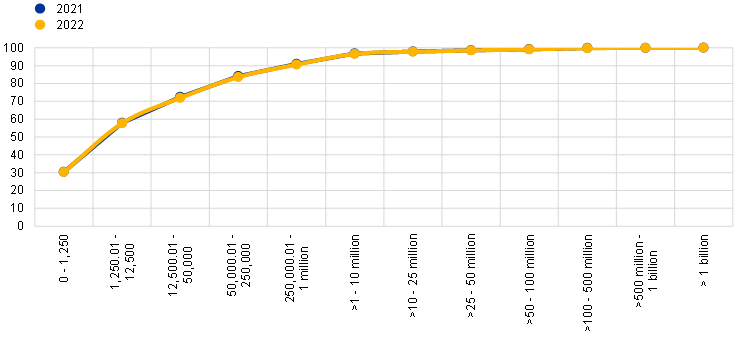
Source: TARGET2
On average, almost 219 payments with a value of more than €1 billion were made per day, accounting for 0.05% of payment flows. Given the wide distribution of transaction values, the median payment in TARGET2 is calculated as €6,500, which indicates that half of the transactions processed in TARGET2 each day were for a value lower than this amount. This figure confirms that TARGET2 offered a range of features attracting a large number of low-value transactions, especially those of a commercial nature. Although the picture changed slightly following completion of the migration to SEPA, particularly with regard to commercial payments, TARGET2 was still widely used for low-value payments in 2022, in particular urgent customer transactions. This is not unusual in the field of large-value payments and is also observed in other systems worldwide. It remains to be seen whether the increased prominence of instant retail payments will have an impact on this trend for similar systems in the future.
Chart 15
Intraday pattern: average value of a TARGET2 payment
(EUR millions)
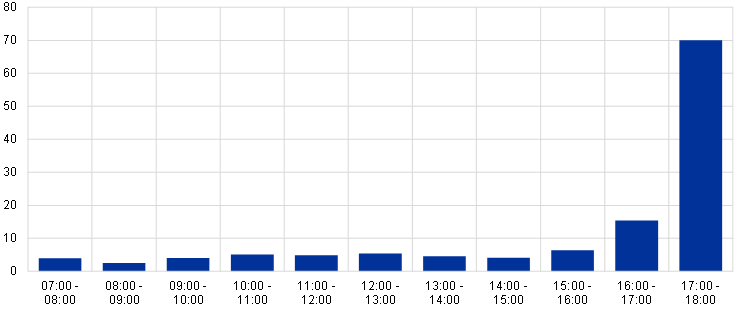
Source: TARGET2.
Chart 15 depicts the average value of TARGET2 payments executed at different times of the day. The chart indicates that in 2022, as in previous years, TARGET2 settlement showed a strong intraday pattern. After the system opened at 07:00 CET, the hourly average value of transactions fluctuated minimally throughout the day. Between 09:00 CET and 13:00 CET, the average value increased slightly owing to the settlement of CLS and other ancillary system transactions. A more visible increase was recorded between 16:00 CET and 17:00 CET relating to an optional cash sweep from T2S DCAs to TARGET2 and ancillary systems such as EURO1 settling their cash balances in TARGET2. The last hour of operations, between 17:00 CET and 18:00 CET, was reserved for interbank transactions, while the cut-off time for customer payments was 17:00 CET. The average size of payments increased dramatically at this time, owing to banks squaring their balances and refinancing themselves on the money market. Overall, the last two hours of TARGET2 operations were characterised by a limited number of transactions, but at very high values.
The average payment value in 2022 during the last opening hour of TARGET2 was largely equivalent to that in 2022.
The chart does not take into account payments that took place before the start and after the end of the business day, since these transactions fall under the night-time settlement category (Section 1.7) and related strictly to accounting practices, for example liquidity transfers from the local accounting systems of central banks, the fuelling of sub-accounts, and T2S DCAs.
1.7 Night-time settlement in TARGET2
TARGET2 operated during the day from 07:00 CET to 18:00 CET, and also offered the ability to settle payments at night. Although the system was open for regular payments from financial institutions and ancillary systems during the day-trade phase, night-time settlement was only for ancillary systems connecting via the Ancillary System Interface (ASI) and liquidity transfers to/from T2S and TIPS.[18] Other operations, such as bank-to-bank transactions or customer payments, were only allowed during the day.
There were two night-time settlement windows: 19:30 CET to 22:00 CET and 01:00 CET to 07:00 CET. The two windows were separated by a technical maintenance window, during which no settlement operations were possible.
Since the system was closed at night to any other form of payment processing, ancillary systems could take advantage of banks’ stable and predictable liquidity positions and settle their transactions efficiently and safely. In general, the night-time windows were mainly used by retail payment systems. In 2022, an average of around 1,815 payments representing a value of €15. 40 billion were settled every night in TARGET2. Compared with 2021, this constitutes a decrease of about 16.91% in terms of value of payments and 3.46% in volume.
Chart 16 shows how the volumes and values settled in TARGET2 during the night evolved after 2009. The increase in volume in November 2011 occurred as a result of the SEPA Clearer ancillary system starting to make use of the night-time settlement service in TARGET2. From then on, the number of payments settled at night increased steadily, notably in 2014, while values remained fairly stable. The trend reversed in 2015, with night-time settlement values and volumes decreasing continuously thereafter. As indicated above, the changes in the night-time settlement pattern in this period can be attributed primarily to securities settlement systems migrating their operations to T2S. From December 2018 onwards night-time settlement values and volumes reached historically low levels because some ancillary system activity moved to the day-trade phase.
Chart 16
Night-time settlement in TARGET2
(left-hand scale: number of transactions; right-hand scale: EUR billions)
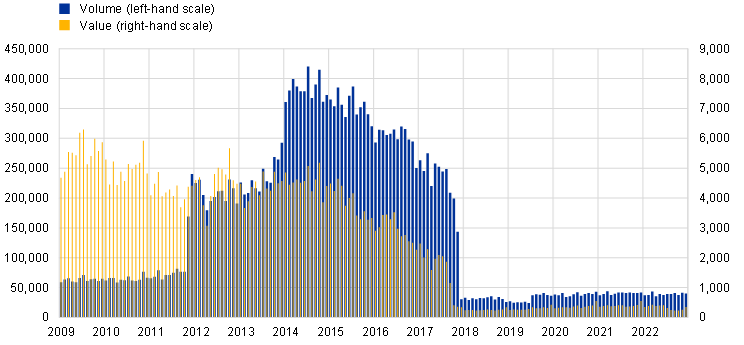
Source: TARGET2.
1.8 Payment types in TARGET2
Charts 17 and 18 present a breakdown of TARGET2 volumes and turnover by type of transaction. Traffic is divided into four categories: payments to third parties (for example interbank transactions and customer transactions), payments related to operations with the central bank (such as monetary policy operations and cash operations)[19], ancillary system settlement, and liquidity transfers between participants belonging to the same group.
About 84% of TARGET2 volume in 2022 was made up of payments to third parties, i.e. between market participants. The volume of ancillary system settlement represented 7% of the total, while 7% was generated through operations with the central bank and the remaining 3% linked to liquidity transfers. Overall, these figures were similar to those for the previous year.
Chart 17
Breakdown of TARGET2 volumes in 2022
(percentages)
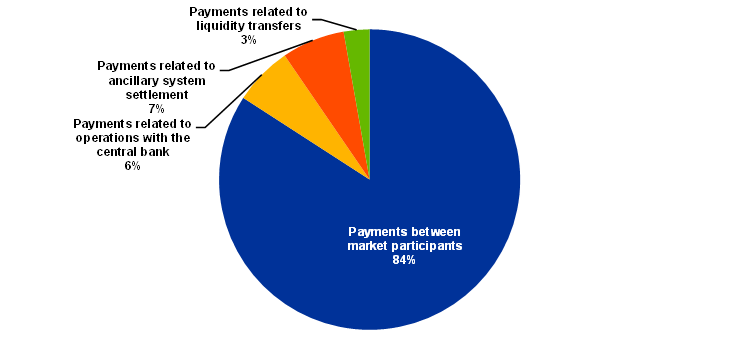
Source: TARGET2.
Chart 18
Breakdown of TARGET2 turnover in 2022
(percentages)

Source: TARGET2.
With regard to turnover in the year, payments between participants represented only 40% of total value. The value of ancillary system settlement made up 13% of the total volume, 20% was generated through operations with the central bank and the remaining 27% linked to liquidity transfers. Overall, these figures were similar to those for the previous year.
The difference between volume-based and value-based indicators across payment categories stems from the fact that the average sums involved in monetary policy transactions, ancillary system instructions and liquidity transfers were typically much larger than payments to third parties.
1.9 The use of prioritisation
Priority options helped TARGET2 participants to optimise their liquidity usage by allowing them to reserve a certain amount of liquidity for specific payment priorities. When submitting payments in TARGET2, participants could assign them a priority: “normal”, “urgent” or “highly urgent”. In general, payments were settled immediately on a “first in, first out” basis, as long as sufficient liquidity was available in the participant’s RTGS account. However, if this was not the case, payments that could not be settled immediately were queued according to priority. Participants could reserve a set amount of their liquidity for the “urgent” and “highly urgent” priority classes, and less urgent payments were made when excess liquidity was sufficient. This was a way of securing liquidity for more urgent payments. The priorities for pending transactions could be changed at any time via the information and control module (ICM).
Chart 19 gives an overview of the use of priorities in TARGET2 in terms of the overall TARGET2 volume in 2022. It shows that 87% of transactions were “normal” priority, 7% were “highly urgent” and the remainder were “urgent”. The distribution of the use of priorities when submitting payments to TARGET2 was stable over the years.
Chart 19
Use of priorities in TARGET2 in 2022
(percentages)

Source: TARGET2.
1.10 Non-settled payments
Non-settled payments in TARGET2 were transactions that had not been processed by the end of the business day, for example because they were erroneous, insufficient funds were held in the account to be debited, or a sender’s limit had been breached. The transactions were ultimately rejected. Chart 20 shows the monthly evolution of the daily average of non-settled payments in volume and value terms between 2009 and 2022.
In 2018 the average daily number and value of non-settled transactions fell sharply, driven mainly by the migration of one of the securities settlement systems to T2S at the end of 2017. As a result of its gross settlement model, some of its transactions were rejected, owing to either insufficient liquidity or cancellation, and reported as non-settled TARGET2 payments. In 2022 the average daily number of non-settled transactions increased to 422, compared with 278 in 2021. The average total value of these transactions increased to €2.8 billion in 2022, compared with €0.9 in 2021.
Chart 20
Non-settled payments in TARGET2
(left-hand scale: number of transactions; right-hand scale: EUR billions)

Source: TARGET2.
Non-settled payments in 2022 represented less than 0.01% of the total daily volume and about 0.01% of the total daily turnover in TARGET2. These levels may be considered very low and confirm that liquidity was appropriately distributed across participants throughout the period.
1.11 Use of credit lines in TARGET2
The intraday credit line was a facility in TARGET2 through which banks could overdraw their intraday account against eligible collateral. In 2022 the average maximum intraday credit line at participant level stood at €1.90 billion, largely in line with the €1.81 billion seen in 2021. Average usage was also largely unchanged, with 2.45% of payments settled using the intraday credit line in 2022, compared with 2.55% in 2021 (Chart 21). In the last months of the year average usage of the credit line returned to the levels observed before mid-2021.
With large amounts of central bank reserves available on their TARGET2 accounts, participants were less reliant on intraday credit lines. This trend had been observed since the start of the ECB’s asset purchase programme (APP). It continued in 2020 and 2021, when additional stimulus was provided by the Eurosystem in response to the COVID-19 pandemic. The average maximum intraday credit line at participant level increased from €1.90 billion in October to €1.94 billion in November and €2.25 billion in December. This coincided with repayment of part of the Eurosystem’s targeted longer-term refinancing operations (TLTRO) between November and December, which freed up collateral and reduced excess liquidity.
Chart 21
TARGET2 intraday credit line and its usage
(left-hand scale: EUR billions; right-hand scale: percentages)
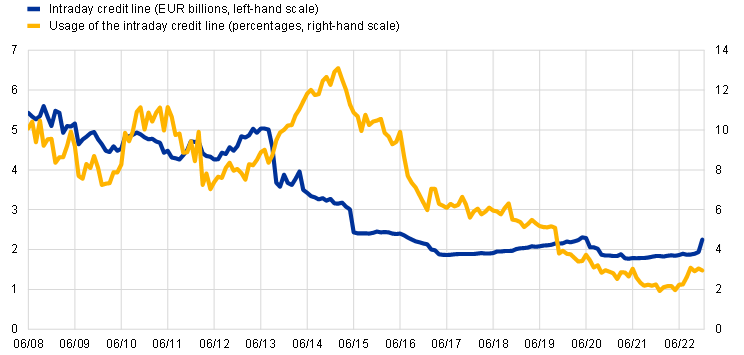
Source: TARGET2.
Notes: The chart covers the period from June 2008 to December 2022. Figures represent monthly averages. The intraday credit line is calculated as the maximum intraday credit that can be accessed, on average, by one bank during the day against collateral posted. The usage of the intraday credit line represents the percentage of payments that are settled using the intraday credit line. Calculations exclude TARGET2 accounts that do not have an intraday credit line set and follow McAndrews, J. and Rajan, S., “The timing and funding of Fedwire Funds transfers”, Economic Policy Review, Federal Reserve Bank of New York, 2000.
1.12 Share of inter-Member State traffic
The share of inter-Member State traffic in TARGET2 indicates the percentage of traffic that was exchanged between participants belonging to different banking communities. Chart 22 shows that there has been a positive trend for both volume-based and value-based indicators since 2009. This trend reflects the increasing level of financial integration in the large-value payment segment, which is mainly supported by TARGET2. This trend continued in 2022, with the share reaching 50% in volume terms, and 45.8% in value terms.
Chart 22
Share of inter-Member State traffic in TARGET2
(percentages)
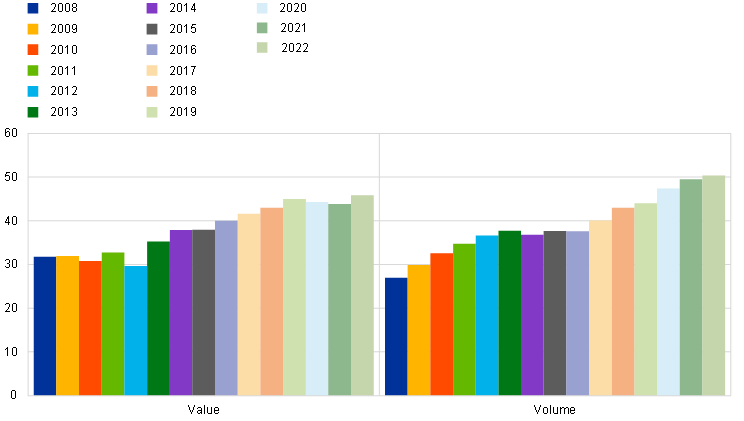
Source: TARGET2.
When analysing these data, it should be borne in mind that whether a payment is sent or received by a given banking community may depend more on a bank’s internal organisation than on its real geographical domicile. For example, a subsidiary of a French bank located in Italy, because of its internal organisation, may send TARGET2 payments to another bank also located in Italy via its headquarters in France. In this case, the payment flow will be considered to be cross-border, even though the payment is taking place between two entities located in the same country. In contrast, banks located in European Economic Area (EEA) countries whose central banks do not provide TARGET services, such as the Czech Republic or Sweden, could participate in TARGET2 component systems provided by other central banks. For example, if a Swedish bank participating in TARGET2-Bank of Finland sent TARGET2 payments to banks in Finland that also participated in TARGET2-Bank of Finland, the payment flows would be considered domestic, even though they took place between entities located in different countries.
The inter-Member State payments depicted in Chart 22 were identified based on the national banking communities of the sending and receiving direct participants on the platform. Since it was also possible to connect to TARGET2 from a non-EEA country, for example as an indirect participant or an addressable Bank Identifier Code (BIC) holder, changes in the cross-border share in terms of volume were also computed on the basis of the originator and the beneficiary of the payment, taking into account the full payment chain information (i.e. originator, sending settlement bank, receiving settlement bank and beneficiary). When calculating the inter-Member State shares based on originator and beneficiary of payment, the share of cross-border payments in 2022 stood at 62.84% in terms of volume and 40.29% in terms of value. Taking the full payment chain into account therefore leads to a cross-border share that is significantly higher in volume but lower in value.
1.13 Tiering in TARGET2
Tiered participation arrangements occur in a payment system when a direct participant of that system provides services that allow other participants to access the system indirectly. The indirectly connected participants benefit in turn from the clearing and settlement facility services offered by direct participants.
While indirectly connected parties, i.e. indirect participants and addressable BIC holders, benefit from a settlement facility that would otherwise be costly to access directly, these types of arrangement also entail risks. Tiered participation arrangements can create dependencies that may lead to overall credit, liquidity or operational risks for the payment system, its participants and the stability of the banking system. Close monitoring of the tiering level in TARGET2 was thus of paramount importance. It was also an oversight requirement under Article 17 of the SIPS Regulation.[20]
The image below shows the map of TARGET2 flows based on the location of payment originators and final beneficiaries. The institutions at both ends of the payment chain are a reflection of the global reach of TARGET2.
Figure 1
TARGET2 transfers based on the location of the originator and final beneficiary banks
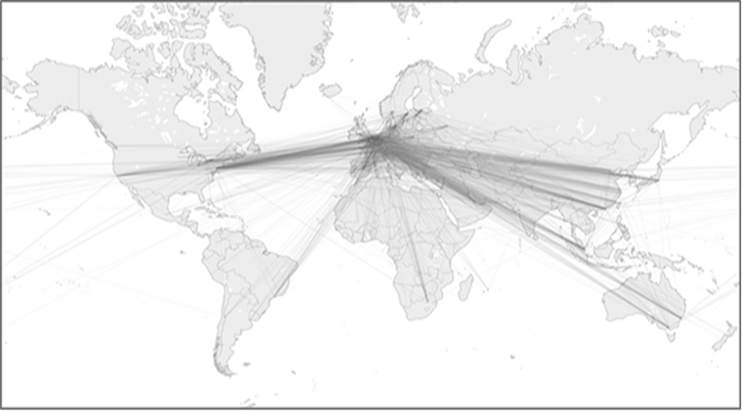
Source: TARGET2.
In 2022 the aggregate level of tiering on the sender side in TARGET2 reached around 7.0% in terms of value and 22.9% in terms of volume (Chart 23). This meant that, on average, for every euro sent by direct participants in TARGET2 during the year, only 7.0 cents were settled on behalf of indirectly connected parties outside their banking group. More than 75% of the tiered business (consolidated at banking group level) came from outside the EEA, showing that TARGET2 made it possible for institutions around the world to access the euro market.
Chart 23
Tiering by sender in TARGET2
(x-axis: ten-day moving averages; y-axis: percentages)
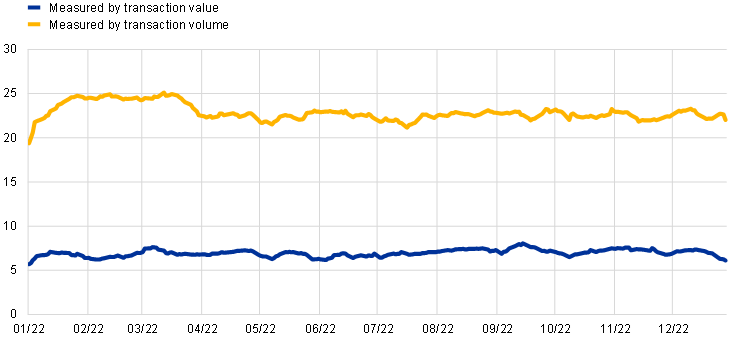
Source: TARGET2.
The largest indirect participant in terms of value sent (consolidated at banking group level) was ranked approximately 49th out of all TARGET2 participants in 2022.
Further analysis reveals that 57.31% of all direct participants in TARGET2 (consolidated at banking group level) did not conduct any business during the year on behalf of indirect parties. Chart 24 shows that around 447 direct participants did not send any tiered payments, while 63 sent payments on behalf of only one tiered banking group in 2022. At the other end of the spectrum, around 81 direct participants acted as a settlement bank for more than 100 tiered banking groups.
Overall, these statistics point to a relatively stable and contained level of tiered participation in TARGET2.
Chart 24
Tiered groups per direct participant group
(x-axis: tiered participants; y-axis: direct participants)
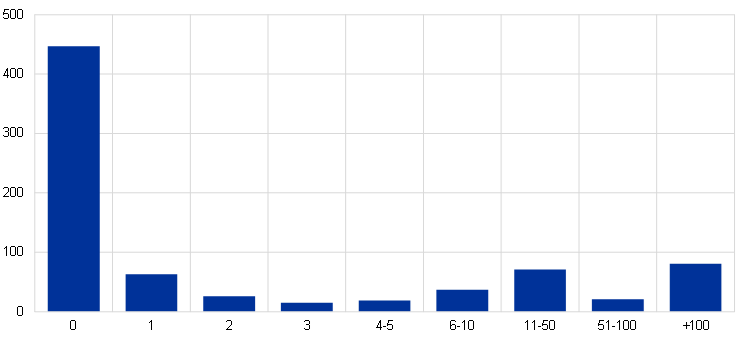
Source: TARGET2.
Box 4
The impact of Russia’s invasion of Ukraine on TARGET2
With the outbreak of Russia’s full-scale invasion of Ukraine in February 2022, the system operator started to assess the possible implications for TARGET2 to avoid any potential negative impact. This assessment covered different areas, but concentrated mainly on analysing the activity of Russian banks’ settling euro payments in TARGET2 and monitoring specific TARGET2 participants particularly affected by the market instability the Russian aggression generated, such as central counterparties (CCPs).
Russian banks had two ways of accessing TARGET2 services. Subsidiaries of Russian banking groups licensed in the European Economic Area (EEA) could be direct participants and hold an account in TARGET2 with a euro area central bank. Six subsidiaries of Russian banking groups were direct participants in February 2022. They settled an average of 1,906 daily payments for a total value of €2.9 billion, and the total liquidity in their TARGET2 balance at the start of day was on average €729.7 million. After the Russian aggression in Ukraine two of these banks stopped operating and one changed ownership. At the end of 2022, only three Russian subsidiaries were active as direct participants in TARGET2: overall, they settled 764 daily payments for a value of €0.2 billion and owned €3,665.8 million of liquidity in their accounts on average in December 2022.
Russian banks outside the EEA could settle euro payments in TARGET2 using correspondent banking services offered by direct participants. In February 2022, 277 banks in Russia, including their local subsidiaries, accessed TARGET2 as “addressable BICs”, a form of indirect participation from non-EEA countries (see Chart A). At the end of 2022 only just over 100 banks in Russia sent or received euro payments in TARGET2, a drop of 63% compared with February. The number of direct participants acting as correspondents for Russian banks remained essentially stable over the same period; there were 106 in February and 95 in December, with a small increase over the spring and summer months.
Chart A
Number of Russian banks settling euro payments in TARGET2 and related correspondents

Source: TARGET2, ECB calculations.
In response to the invasion the EU issued a series of sanctions directed against banks in Russia. These extended the capital market sanctions issued in 2014[21] and imposed further financial restrictions, including an asset freeze and exclusion from SWIFT. Traffic sent by sanctioned Russian banks in TARGET2 fell drastically both in number and, in particular, value of payments (see Chart B). The number of payments sent remained more or less stable until March at around 80,000 per month. The first significant drop occurred in April, when the SWIFT ban became effective and the number of payments plunged to below 20,000. After that it showed significant volatility, with end-of-quarter peaks, but never returned to pre-invasion levels. Values showed a different pattern. Following an increase in the pre-invasion period, with more than €140 billion settled in January and almost €110 billion in February, the value of payments from sanctioned Russian banks plunged to less than €20 billion in March and decreased further over the following months to just over €6 billion in December. Overall, both indicators show a significant downward trend from spring 2022 that is in line with the severity of the sanctions imposed and confirms their effectiveness.
Chart B
Traffic by sanctioned Russian banks in TARGET2 in 2021-2022
(left scale: value of transactions, EUR billions; right scale: number of transactions, thousands)
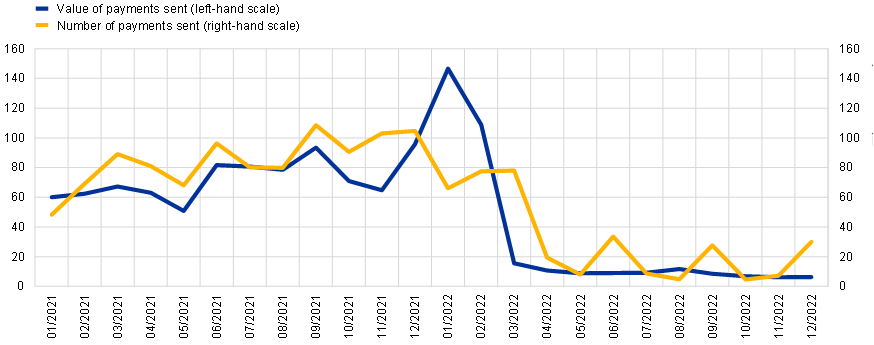
Source: TARGET2, ECB calculations.
Note: Data include all banks under EU sanctions as at end-December 2022, without differentiation as to when the sanctions for individual banks were enacted.
Non-sanctioned Russian banks sending payments in TARGET2 through direct participants showed a slightly different pattern after the invasion (see Chart C). The volume of payments sent jumped in early 2022, reaching 50,000 in March and peaking at approximately 90,000 in April. Although the figure declined steadily over the rest of the year, the number of payments sent in December was still higher than the average for 2021 (50,000 compared with approximately 46,000).
Chart C
Traffic by non-sanctioned Russian banks in TARGET2 in 2021-2022
(left scale: value of transactions, EUR billions; right scale: number of transactions, thousands)
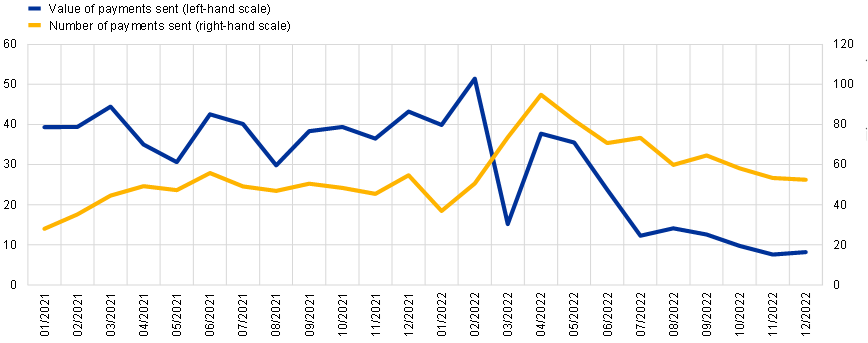
Source: TARGET2, ECB calculations.
Note: Data do not include banks under EU sanctions as at end-December 2022, without differentiation as to when the sanctions for individual banks were enacted.
The total value of transactions sent by non-sanctioned Russian banks in TARGET2 also plummeted at the time of the invasion, dropping from almost €55 billion in February to less than €20 billion in March. However, it rose again to almost €40 billion in April and May, after which it fell steadily to less than €10 billion at the end of the year.
One of the consequences of the Russian aggression was a steep rise in energy prices, which impacted European central counterparties (CCPs) settling in TARGET2. The rapid increase affected margin requirements on derivatives portfolios and caused CCPs’ balances held in TARGET2 to rise, as payments related to margin calls from clearing members increased.[22] Between September 2021 and March 2022 six CCPs experienced significant increases in the liquidity held in their TARGET2 accounts. In the light of the volatility in natural gas and power futures prices after the Russian invasion and the general volatility in financial markets, the system operator monitored changes in the balances held by these CCPs in TARGET2 closely from March onwards.
Their overall balance was around €76 billion in the first eight months of 2021 (see Chart D) and rapidly increased throughout September of that year to €98 billion. From the end of November it grew even further, reaching €189 billion on 24 December 2021. With the start of the invasion and the related turmoil on financial markets, the overall balance increased to €227 billion on 9 March 2022. It then followed a volatile pattern until the end of August, when it reached a peak of €246 billion. From September it fell steadily to €127 billion on 27 October, hovering around €135 billion thereafter.
Chart D
Overall balances of selected CCPs
(EUR billions)
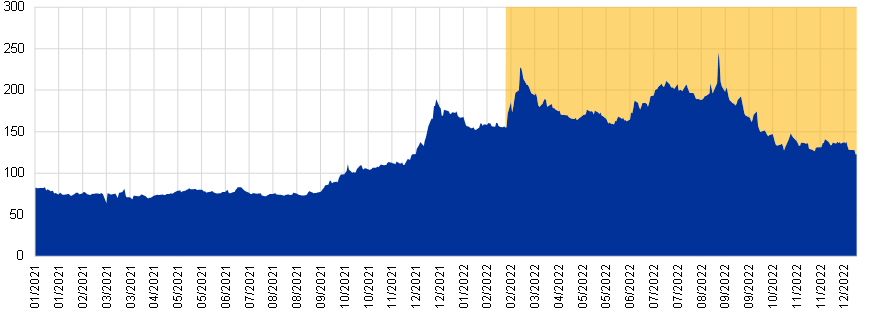
Source: TARGET2, ECB calculations.
The operator remains attentive to ongoing developments to pre-empt possible adverse impacts on the system and its participants.
1.14 Money market transactions in TARGET2
Market participants used TARGET2 to settle unsecured money market transactions in central bank money. By applying the Furfine algorithm[23] it is possible to identify TARGET2 transactions which were related to money market loans, or, more precisely, to the unsecured overnight money market.[24] This unique dataset is updated regularly to obtain the latest information about the money market. Overall, TARGET2 transaction data provide a rich source of information for analysing monetary policy implementation and TARGET2 operations. The importance of the money market is twofold: (i) it is an important vehicle for redistributing liquidity among TARGET2 participants; (ii) it is a large-value and time-critical area of business that the operator needs to be aware of, in particular when dealing with abnormal situations.
The dataset was developed using the TARGET2 simulator environment and comprises data from June 2008 onwards.[25] In 2022 around 29,388 money market loans with a total value of about €2.42 trillion were identified. This corresponded to a daily average of 114 money market loans, with a value of about €9.41 billion (Chart 25). Overall, the amount of unsecured funds traded on the overnight market remained at low levels compared with the period before the financial and sovereign debt crises. Activity increased slightly in July as a result of the monetary policy decisions taken, although with no disruptive effects.[26]
Chart 25
Unsecured overnight money market activity in TARGET2
(daily averages per month, left-hand scale: EUR billions; right-hand scale: number of transactions)

Source: TARGET2.
Chart 26 complements this analysis by showing the cumulative distribution in value of all money market transactions during the day in 2022. On the lending leg, 50% of total value was settled by around 15:25 CET, while 98% was settled by around 17:35 CET. This confirms the assumption that the last few hours of TARGET2 operations were particularly important for the interbank market. Three-quarters of loans were repaid by around 12:00 CET and 90% by around 14:30 CET. These patterns ensured that liquidity repaid could be reused for payment purposes later that day.
Chart 26
Cumulative distribution of money market transactions during the day in value terms
(percentages)
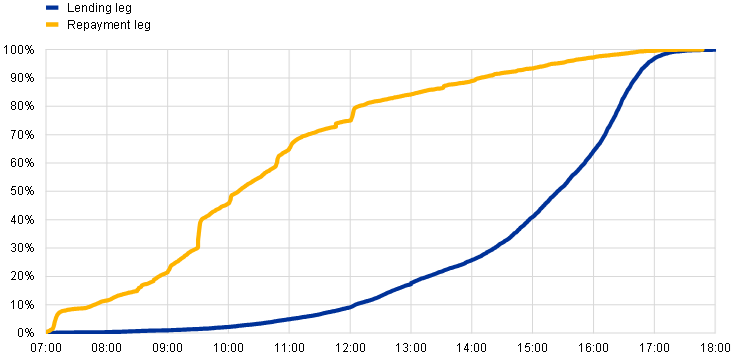
Source: TARGET2.
Box 5
The impact of ECB monetary policy decisions on money market rates derived from TARGET2
Amid surging levels of inflation, the Governing Council raised the three key ECB policy rates four times in 2022. Between July and December these increased by a total of 250 basis points, as a result of two 50-basis point hikes (on 27 July and 21 December) and two 75-basis point hikes (on 14 September and 2 November). The deposit facility rate rose steadily from -0.50% to 2.00%. This box focuses on the evolution of overnight unsecured money market activity derived from TARGET2 data following the monetary policy decisions taken in 2022.
The granularity of TARGET2 data enabled the operator to design a way to identify and monitor money market developments in TARGET2 in terms of activity, rate and concentration. This was complemented by a regular comparison with changes in the euro short-term rate (€STR) and statistics on money market transactions collected for the Money Market Statistical Reporting (MMSR) Regulation.[27] The analysis allowed for a cross-check of the robustness of the implementation of the Furfine algorithm[28] and at the same time gave a better understanding of the drivers of traffic.
Transmission of rate hikes to overnight unsecured money market transactions in TARGET2 in 2022 was broadly complete and immediate. The derived rate based on TARGET2 money market activity adjusted smoothly to the new policy rate, increasing by 50 basis points in July, 74 basis points in September, 72 basis points in November and 49 basis points in December (see Chart A). It also closely followed the rate hike pass-through to the €STR; the gap between the two rates on each day a new rate became effective was never wider than two basis points. In terms of activity, the rate hikes had no disruptive effects on the money market. The policy rate hikes in July and November led to variations in the daily average activity of the respective ECB reserve maintenance periods (MPs) of the order of €0.4-0.5 billion (see Chart A). Conversely, the September rate hike led to an increase of €2.0 billion in the daily average activity of the respective MP.[29]
Chart A
Overnight unsecured money market rate and activity in TARGET2 against €STR in 2022
(left y-axis: basis points; right y-axis: EUR billions)
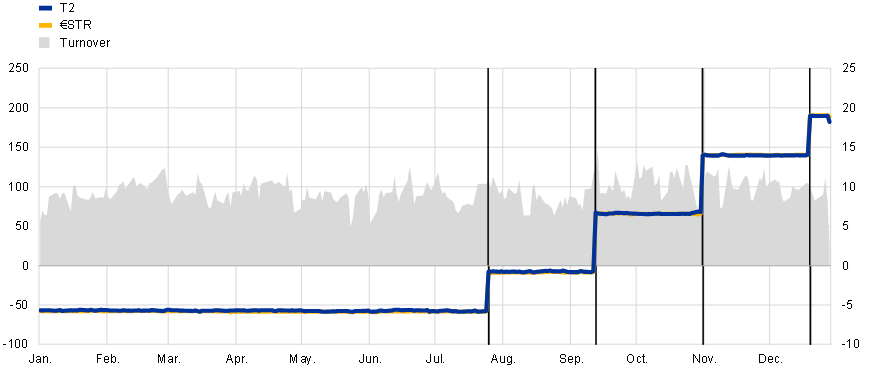
Source: TARGET2, MMSR, ECB calculations.
Note: The overnight unsecured money market rate derived from TARGET2 is computed as a volume-weighted trimmed mean overnight borrowing rate, in line with the €STR. The vertical lines mark the first day of each MP when a new rate became effective.
Overall, TARGET2 data continued to be a reliable source for analysing the overnight unsecured money market segment in euro in 2022 and a valuable term of comparison for calculations made on reported data. The derived rate followed the developments observed in the €STR closely, confirming its validity. Once the consolidated T2-T2S platform has gone live in March 2023, the operator will adapt the implementation of the Furfine algorithm to the new system configuration. This will ensure continuity in monitoring.
1.15 Shares of national banking communities
The following two charts break down TARGET2 volumes and turnover according to the share of the biggest national banking communities contributing to its traffic.
Chart 27
Country contributions to TARGET2 volume
(percentages)

Source: TARGET2.
Chart 28
Country contributions to TARGET2 value
(percentages)

Source: TARGET2.
As in previous years, the largest contributor to TARGET2 traffic in volume terms in 2022 was Germany, which accounted for more than half of the transactions settled in the system. The addition of France, Italy, Spain, the Netherlands and Belgium increases the share of transactions to 87.5%, which is on a par with previous years. The shares of the biggest contributors to TARGET2 volumes remained stable.
Germany is also the main contributor by turnover, followed by France, Luxembourg and the Netherlands. The top four countries by turnover generated over three-quarters of the total value settled in TARGET2 in 2022. The concentration of turnover remained stable compared with the previous year.
The high concentration of both TARGET2 values and volumes in certain countries was not only due to the size of particular markets. It can also be attributed to the fact that from November 2007 onwards the system allowed activities of banking groups to be consolidated in a single RTGS account held by the group’s head office, increasing concentration in countries where a large number of these groups are incorporated.
1.16 Pattern of intraday flows
Chart 29 shows the intraday distribution of TARGET2 traffic, i.e. the percentage of daily volumes and values processed at different times of the day in 2022. This indicator is significant for the operator as it represents the extent to which settlement is evenly spread throughout the day or concentrated at certain peak times. Ideally, the value/volume distribution should be as linear as possible to avoid liquidity and operational risk.
Chart 29
Intraday distribution of TARGET2 traffic in 2022
(percentages of daily volumes and values)
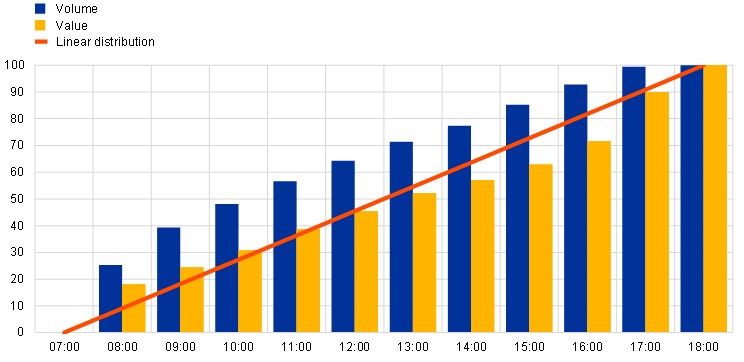
Source: TARGET2.
In value terms, the path was typically very close to linear distribution, indicating an even spread throughout the day, which in turn ensured smooth settlement of TARGET2 transactions.
In volume terms, the curve was well above the linear distribution, with over one-fifth of transactions submitted to the system within one hour of the start of operations – including transactions sent at night and warehoused payments – and almost half submitted within three hours of the start. One hour before the system closed, almost 100% of the TARGET2 volume had already been processed. A comparison with previous years shows no significant deviations.
2 TARGET2 service level and availability
In 2022, as in 2021, 99.99% of all payments settled in the payments module of TARGET2 were processed in less than five minutes.
Service delivery times and payment processing times generally remained stable in 2022, confirming the high performance level of TARGET2’s SSP. This excellent performance was advantageous for the banking community, particularly for its real-time liquidity management.
Payment processing times were measured for all payments settled in TARGET2, with the exception of: (i) ancillary system settlement transactions using the ASI, (ii) payments settled during the first hour of operations (see the “morning queue effect” below) and (iii) payments not settled owing to a lack of funds or a breach of limit. In practice, around 30% of all TARGET2 payments fell into these three categories, meaning that the statistics on processing times applied to around 70% of the system’s traffic.
99.94%[30] of requests or enquiries were processed in less than one minute and only 0.06% in one to three minutes, with levels remaining the same as in 2021.
Chart 30 helps to better quantify the system’s performance by showing the distribution of processing times on the SSP, i.e. the percentage of traffic with a processing time below a certain number of seconds. The reference point taken is the peak day of the year, 19 April 2022, when 622,003 payments were settled. The chart shows that on this day 50% of transactions were settled within 26 seconds and 90% within 38 seconds, confirming the system’s high level of performance.
Chart 30
Processing times on 19 April 2022, excluding the first hour
(x-axis: seconds ; y-axis: percentages)

Source: TARGET2.
A phenomenon worth reporting in the context of TARGET2 performance is the “morning queue effect”. When TARGET2 started daylight operations at 07:00 CET, a large number of transactions (about 20% of the daily volume on peak days) were already waiting for settlement. They were either payments submitted by banks on previous days with a future value date (i.e. “warehoused payments”) or payments released by banks via SWIFT in the hours preceding the opening of the system. On peak days more than 100,000 transactions may have been processed in the first hour, which affects the average settlement time during this period. This huge volume of transactions normally took around 30 to 45 minutes to process. In order to neutralise this effect, the first hour of operations was excluded when TARGET2 processing times were calculated.
Specifically, in the first hour the use of urgency flags (“urgent” and “highly urgent”) was still recommended for payments considered time-critical (such as CLS pay-ins). This circumvented settlement delays by using different queues (one for each type of priority). In addition, attention should be drawn to the possibilities offered in TARGET2 to reserve funds for highly urgent and urgent payments (see Section 1.9).
2.1 Technical availability
In the light of TARGET2’s importance for the functioning of the financial system and the knock-on effects that any potential malfunctions could have had on other market infrastructures, the Eurosystem paid particular attention to ensuring its smooth operation. This is clearly underlined by the fact that the SSP of TARGET2 achieved 100% technical availability in 2022.
Technical availability was measured on TARGET2 business days during the day-trade phase (including end-of-day processing), from Monday to Friday between 07:00 CET and 18:45 CET (19:00 CET on the last day of the minimum reserve period), including any extensions required to complete the operational day (e.g. delayed closing owing to a technical problem in TARGET2 – or in T2S, which has an effect on TARGET2 – or major problems in ancillary systems settling in TARGET2). The availability measurement did not include systems or networks not directly managed by TARGET2 (in particular, the availability of SWIFTNet services). Incidents occurring during night-time settlement were not included either.
Technical availability was not intended to measure the impact of partial outages involving the TARGET2 SSP. For example, incidents affecting only the processing of ancillary system transactions without any effect on other payment processing activities could not be measured in this figure, although they had an overall impact on TARGET2 and were taken into account when assessing the system’s performance. However, such incidents were considered when measuring processing times where applicable, and were also reported transparently and followed up accordingly.
2.2 Incidents in TARGET2
The ECB published up-to-date information about the availability of TARGET2 via the Market Information Dissemination tool.[31] All incidents were followed up with a detailed incident report and risk management process. The aim of this approach was to learn from these events in order to avoid a recurrence or incidents of a similar nature.
Chart 31
TARGET2 incidents and delays in closing the system
(left-hand scale: number of incidents/delays; right-hand scale: yearly data in percentages)
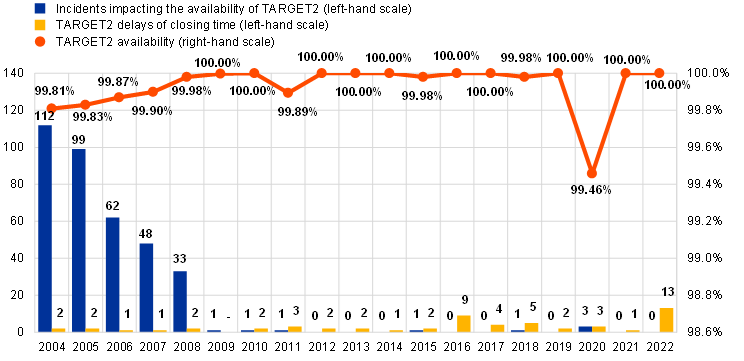
Source: TARGET2.
TARGET2 did not experience any incidents in 2022 that suspended the settlement of payments.
The closing of the interbank payment cut-off at 18:00 CET was nevertheless delayed on 13 occasions, a significant increase compared with previous years. Most of these were related to problems in T2S which prevented the timely repatriation of funds to TARGET2 RTGS accounts.
Box 6
Enhancements to TARGET services communication tools
In December 2020 the ECB appointed Deloitte GmbH to conduct an independent review[32] of five major information technology-related incidents which occurred in 2020, affecting payment transactions and securities processing of TARGET services. The review aimed to identify the root causes of the incidents, draw more general lessons and propose recommendations in the following six key areas: (i) change and release management, (ii) business continuity management, (iii) failover and recovery tests, (iv) communication protocols, (v) governance, (vi) data centre and IT operations.
In the second half of 2021 the Eurosystem prepared an action plan[33] to address the issues and recommendations raised by Deloitte in a timely manner.
Measures dealing with several recommendations were agreed or implemented in 2021, and most of those remaining were implemented in 2022. The Advisory Group on Market Infrastructures for Payments (AMI-Pay)[34] and the Advisory Group on Market Infrastructures for Securities and Collateral (AMI-SeCo)[35] were regularly updated on the implementation of the action plan until completion.
Clear, timely and reactive communication to participants is a key success factor for all financial market infrastructure, not just in crisis situations, but also for less critical events. For TARGET2, this relied on a number of tools at the disposal of TARGET2 central banks. These were enhanced or implemented in 2021 and could be used to inform participants about matters such as the operational status of the system, cut-off changes, insolvency of participants or ongoing disruptions. One more additional enhancement was introduced in 2022.
TARGET services operational status page; email alerts
The TARGET2 Market Information Dissemination (MID) tool allowed up-to-date information about the operational status of TARGET2 to be made available via the ECB’s website. This information covered both normal operations and abnormal situations. In the latter case, the information included the type of failure, its impact and the measures to be implemented to resolve the issue, along with the time of the next update. In 2022 email alerts containing all information about the operational status of TARGET services provided on the ECB’s website were introduced. Participants, news agencies and the general public were able to subscribe to these alerts via the following URL: https://www.ecb.europa.eu/paym/target/html/register.en.html.
All enhancements to the TARGET services communication tools will also be available for the new T2 system from March 2023 onwards.
3 TARGET2 participants
3.1 RTGS accounts
In December 2022 the total number of RTGS accounts active in TARGET2 (encompassing direct participants, technical accounts, ancillary system accounts and special-purpose accounts) was 1,863, i.e. lower than at the end of 2021 (1,958).
Chart 32
Number of RTGS accounts in TARGET2
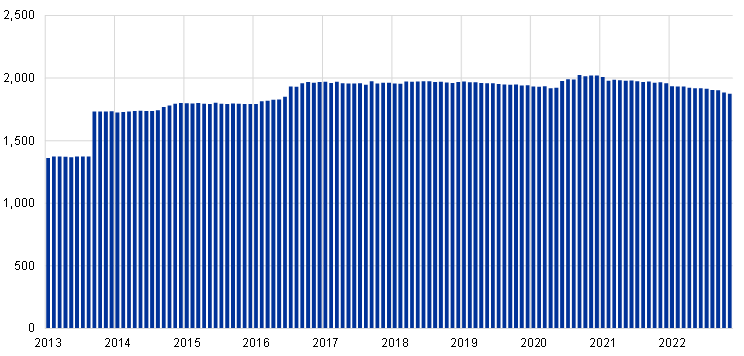
Source: TARGET2.
3.1.1 Internet-based participation
In November 2010 internet-based participation was introduced to allow small banks to obtain a direct connection to TARGET2 without necessarily being connected to the SWIFT network. The service, which was subject to a monthly fee of €70, was designed mainly for low-volume participants that wished to hold an account directly with their central bank, either an RTGS account[36] or a home accounting module account (provided the respective central bank has opted for this module).
While the initial number of internet-based participants was relatively modest (68 at the end of 2012), it increased significantly in 2013 (to 509 participants by the end of that year), with the phasing out of the last proprietary home accounts still offering payment settlement services. Another increase in the second half of 2016 (to 634 participants by September 2016) was caused by some banks opening TARGET2 accounts via internet-based access solely to settle long-term refinancing operations. While total internet-based participation gradually declined from then on, a third increase took place from mid-2020 (to 630 participants by December that year). This increase was also caused by banks opening TARGET2 accounts via internet-based access solely to settle long-term refinancing operations. In December 2022 the overall number of internet-based participants was 575, indicating a gradual decline in this type of participation. The largest share of internet-based participants was in Germany, followed by France and Italy.[37]
Chart 33
Internet-based participants
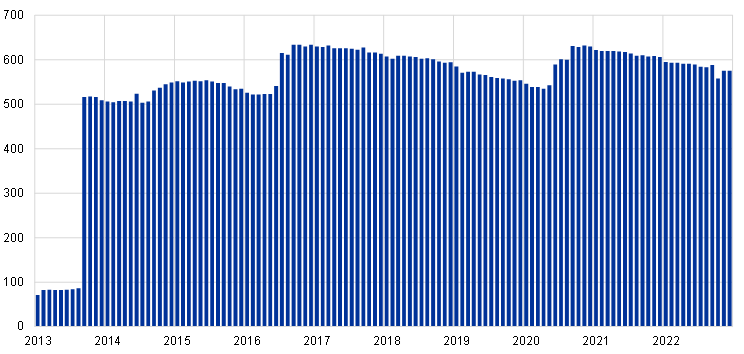
Source: TARGET2.
3.2 Participation types
At the end of December 2022 957[38] direct participants held an account on the SSP of TARGET2 and were registered as such in the directory. Through these, 528 indirect participants from the EEA and 4,611 correspondents worldwide were able to settle their transactions in TARGET2.
Table 2
Participation types
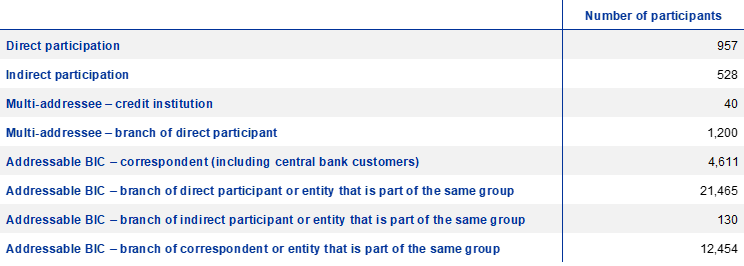
Including the branches of direct and indirect participants, a total of 41,385 BICs around the world (56.56% of them located in the EEA) were accessible via TARGET2 at the end of 2022. Compared with the number of reachable BICs at the end of 2021, this figure represents a drop of around 3%, driven mainly by the decrease in the number of addressable BIC holders associated with branches of direct and indirect participants.
Participants and institutions addressable via TARGET2 were listed in the TARGET2 directory, which was available to all direct participants for information and routing purposes. In addition to direct participants with an RTGS account for sending payments to and receiving payments from other direct participants, a number of banks opted to open special-purpose RTGS accounts which were not reported as direct participants in the TARGET2 directory. These were used, among other things, to settle specific business (for example Eurosystem open market operations) or fulfil reserve obligations in countries where reserves are computed on RTGS accounts. There were 423 of these accounts, also known as “unpublished BICs”, at the end of 2022 (compared with 435 in 2021).
3.3 Ancillary systems
At the end of 2022 a total of 79[39] ancillary systems were using the TARGET2 SSP for settlement purposes, including 32 retail payment systems, 22 securities settlement systems and 17 clearing houses (including six central counterparties).
Of the 79 ancillary systems using the SSP for settlement purposes, 56 made use of the ASI, a feature which was developed to facilitate and harmonise cash settlement of these systems in TARGET2.[40] Table 3 shows the number of times each of the available ASI models was used during the year.
Table 3
ASI settlement model

Notes:
1 An ancillary system may make use of more than one ASI settlement model.
2 As a result of the migration to T2S, model 1 (which supported the integrated model) is no longer used.
4 TARGET2 financial performance
4.1 Cost recovery objectives
The objective initially set by the ECB’s Governing Council in 2007 was for TARGET2 to recover all its costs (with the exception of the “public good factor”)[41] over the six-year amortisation period, i.e. between May 2008 and April 2014. This included development costs, running costs, overhead costs and capital costs.
The evolution of TARGET2’s cost recovery rate since the finalisation of its migration phase in 2008 is shown in Chart 34.
Chart 34
TARGET2 annual cost recovery rate
(percentages)
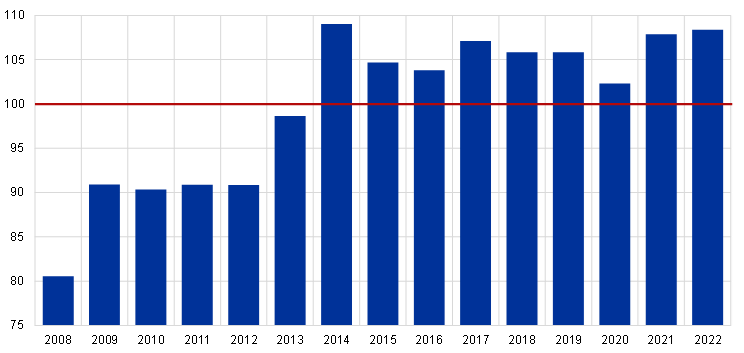
Source: ECB calculations.
Note: The data for 2008 only cover the period July-December.
At the time of TARGET2’s development, a number of assumptions were made about the volume of operations in relation to cost recovery. It was estimated that in the first year of operation (i.e. from May 2008 to April 2009), TARGET2 would settle a total of 93.05 million transactions and that this figure would then need to increase by an average of 6% per year. Although the objective was met the year the system was launched, the overall economic slowdown and exceptional market conditions in the ensuing years made it impossible to meet the targeted 6% increase.
From launch the system saw an average annual decrease in billed traffic of 0.7%, which largely explains why cost recovery was only around 90% for the first few years of operation.
In July 2012, acknowledging this underperformance, the Eurosystem decided to amend the single pricing scheme as of January 2013. The fixed periodic fee for users was increased, while transaction fees remained unchanged. The new pricing scheme represented an acceptable compromise, with a limited increase in participants’ fees and a reasonable extension to the system’s payback period. In 2013 the amended pricing scheme helped to bring cost recovery close to 100%.
By 2014 most[42] of the investment costs were amortised, which substantially reduced the costs still to be recovered and lifted recovery to more than 100%. These annual profits were used to offset the losses accumulated over the first few years of operation.
While TARGET2 generated annual profits from 2014 onwards, the level of cost recovery fluctuated considerably each year. The reasons for this were, first, that the SEPA migration end-date resulted in a one-off drop in the total amount of customer payments settled. Second, T2S migration had an effect from both a cost and revenue perspective. TARGET2 underwent adaptations in preparation for the launch of T2S, the costs of which started to be recouped from 2015 onwards. These adaptation costs were passed on to system participants in the form of a specific fee.[43] The successful migration of the respective CSDs to T2S from June 2015 onwards also reduced the total amount of ancillary system transactions settled in TARGET2.
The total amount of billable traffic in TARGET2 increased by 6.3 million transactions in 2022 and overall revenues increased to €446.2 million. Annual cost recovery also increased to 108.4%.
4.2 Financial performance of TARGET2 in 2022
In 2022 the total annual costs to be recovered for the provision of the core services of TARGET2 amounted to €42.7 million. On the revenue side, TARGET2 participants were billed for 100.6 million transactions, which, together with the fixed monthly fees, generated total revenues of €46.2 million. This resulted in a cost recovery rate of 108.4% and an annual profit of €3.6 million. At the end of 2022 the loss accumulated since the launch of TARGET2 had therefore decreased by the same amount, and stood at €0.2 million. This meant that TARGET2 had fulfilled its cost recovery objective by the time it was replaced by the new T2 system in March 2023.
Chart 35
Accumulated profit
(EUR millions)
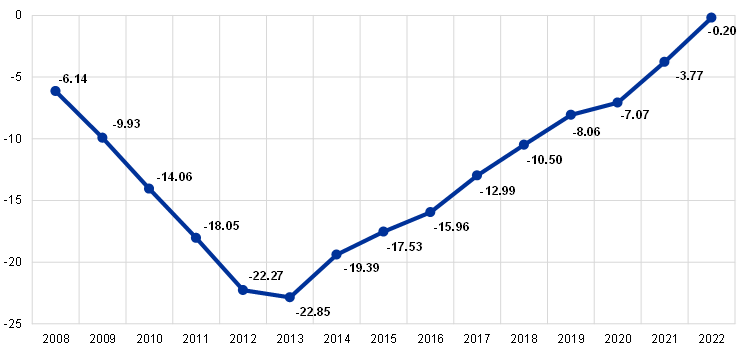
Source: ECB calculations.
Note: The data for 2008 only cover the period July-December.
4.3 Analysis of revenues collected in 2022
Based on 2022 figures, the following observations can be made.
- 94% of direct participants in the SSP opted for the flat fee option (option A), while 6% opted for the degressive fee option (option B).[44] This shows that TARGET2 was capable of attracting both major market players and a large number of small and medium-sized institutions.
- Participants that opted for pricing option B generated, in total, around 89% of billed traffic.[45] As a result of this concentration, 41% of all billed transactions were in the lowest pricing band: €0.125. This demonstrates that key participants, particularly multi-country banks, benefited from the attractive degressive fee option offered by TARGET2 and the competitive group pricing offers.[46]
- Transactions between credit institutions generated around 93% of TARGET2 volumes, with the remaining 7% attributable to ancillary system transactions.
- 75% of TARGET2 revenues were variable, i.e. came from transaction fees, while fixed subscription fees accounted for 25%.
- Measured from the start of the system, total cost recovery of TARGET2 stood at 99.4%.
5 TARGET2 risk management and oversight activities
5.1 TARGET2 risk management
The management of operational risks was key for ensuring the resilience of the TARGET2 service. In December 2021 the Governing Council approved a new TARGET services risk management framework (TS RMF) applicable to all TARGET services (TARGET2, TARGET2-Securities and TIPS). The TS RMF follows up the recommendation from the TARGET2 overseer to establish and document a three-line model.[47] In particular, the TS RMF clarifies the roles and responsibilities of stakeholders (most significantly for the first and second lines of defence) in identifying, assessing and managing operational risks. The second line was established mid-2020 and reports to the Market Infrastructure Board (MIB). Following the MIB’s endorsement of the TS RMF, the resourcing of a fully-fledged second line was completed in December 2021.
The TS RMF consolidates the link to information security risk management processes designed to: (i) monitor developments to ensure that progress on the implementation of security checks in response to issues resulting from risk assessments is satisfactory; (ii) enable those involved to learn from operational experience, ensuring appropriate measures are taken to prevent an incident from recurring; and (iii) proactively identify new threats and vulnerabilities that could emerge from the changing environment and, if needed, initiate deliberations on implementing additional security checks to prevent these threats from materialising.
Now that the consolidation project has gone live, the MIB is preparing to finalise a new TARGET services cyber resilience and information security (CRIS) framework, which will further enhance risk management. This will be implemented incrementally and further improved after its endorsement by the Governing Council, which is planned in the first half of 2023.
5.2 Oversight activities
As part of the continuous oversight cycle, the ECB oversight function organised a number of bilateral meetings at different levels in 2022 between the TARGET2 operator and the ECB as the competent authority, as well as at the level of the European System of Central Banks (ESCB) Committee and working group. The regular meetings allowed for discussion of developments and risks in the system and served as a means for the overseer to effectively monitor the system’s risk profile. In combination with other oversight tools, these allowed the overseers to assess TARGET2’s continued compliance with the SIPS Regulation and other oversight requirements.
In October 2022 the ESCB Market Infrastructure and Payments Committee (MIPC) approved the outcome of the pre-assessment of the consolidated platform prior to its go-live. This was carried out as a major change assessment of TARGET2, as foreseen in the Eurosystem Oversight Guide for SIPS.
To further ensure the resilience of TARGET2, the oversight function continued to follow up on remediation actions taken by the operator to address open findings from previous assessments.
As concerns TIPS, the oversight function reviewed the changes that occurred during the year. These included TIPS Release 5.0 deployed in November 2022, Release 4.1 in May 2022 (including adaptations stemming from the onboarding of Sveriges Riksbank to TIPS) and release R2023.NOV, which is being implemented in 2023 to improve search criteria and query information.
Box 7
TARGET2 analytics for regulatory compliance
As a systemically important payment system (SIPS), TARGET2 was subject to the SIPS Regulation, which establishes a comprehensive regulatory framework for efficient risk management for payment systems by transposing the Principles for Financial Market Infrastructures (PFMIs) drawn up by the Committee on Payments and Market Infrastructures (CPMI) and the International Organization of Securities Commissions (IOSCO) into euro area legislation.
To support compliance with the PFMIs, through the TARGET Analytics Group (TAG) the operator developed a broad quantitative toolkit based on data analytics of granular information on the system’s activity and participants. The Eurosystem’s compliance toolkit ranges from individual statistical indicators to more complex methodologies using advanced analytics and specific tools, such as the TARGET2 simulator. A comprehensive overview of the Eurosystem’s compliance toolkit for risk assessment is provided in the recent ECB Occasional Paper “TARGET2 analytical tools for regulatory compliance”.[48] Given that a wide range of financial market infrastructures (FMIs) from around the world are required to comply with the PFMIs, this is a topic of interest to a vast audience of operators and overseers of systemically important payments systems around the globe.
Quantitative analyses were particularly used by the operator for risk assessment in accordance with the following principles: Principle 3 (risks arising from interdependencies), Principle 7 (liquidity risk), Principle 17 (operational risk) and Principle 19 (tiered participation arrangements). They are also instrumental in supporting compliance with other principles.
The analysis of interdependencies serves to quantify the risks arising from the interconnections that TARGET2 has with other entities, and relies on a broad set of statistical and network indicators based on a general framework established by the CPMI. Various liquidity indicators, including the intraday dimension, and ad hoc studies of liquidity saving features or participants’ payments behaviour are used to monitor and assess liquidity risk. Data analysis supports operational risk monitoring in several ways. Critical credit institutions were identified by combining two criteria: (i) an indicator looking at the turnover generated by participants in the system, and (ii) an analysis of the impact on TARGET2 settlement capacity in the event of a simulated technical failure. The operator also regularly assessed the impact of incidents by looking at cumulative intraday settlement values and volumes and uses an algorithmic methodology to evaluate the potential of operational outages by TARGET2 participants. Finally, risks arising from tiered participation arrangements were evaluated by indicators comparing the sender and receiver of a payment with its originator and beneficiary.
Although they were developed for regulatory compliance, these tools also proved to be an important instrument for monitoring the system and gaining knowledge and understanding of its activity over time. They offered, for example, important insights into traffic patterns, system efficiency, the effectiveness of different system features, liquidity flows, payment patterns, the behaviour of individual participants and their interconnections. The operator used them in its regular activities and as an aid in exceptional events, such as incidents or functional changes in the system. Data analyses also provided pivotal support for decision-making by the operator, and for more general policy discussions of the Eurosystem’s FMIs. This will continue, in view of the future challenges and changes to be faced in the payment systems landscape.
6 System evolution
There were no new releases in 2022. Owing to the limited remaining lifetime, the Eurosystem decided not to seek any change requests from participants. No adaptations were required as part of SWIFT Standards Release 2022.
Box 8
Update on the T2‑T2S consolidation project and future RTGS services (including CLM)
The T2-T2S consolidation project replaced TARGET2 with a new RTGS system and applied a centralised liquidity management (CLM) tool across all TARGET services (T2, T2S, TIPS and the forthcoming ECMS).
The functional specification phase of the project ended in 2020 following the publication of stable User Detailed Functional Specifications (UDFS) and User Handbooks (UHBs). Further updates were made in 2021 to prepare those deliverables for testing.
In 2022 the focus was on the updates required for production by incorporating change requests approved after the publication of UDFSs v2.2 and UHBs v2.0 in 2021. UDFS and UHB v3.0 were published in October 2022.
The T2-T2S consolidation project also published explainers and examples to help market participants better understand certain concepts by gathering information spread across different chapters or specifications books into single documents.
The next versions of the user specifications were published in March 2023 in view of the R2023.JUN (i.e. the first release after going live).
Migration and testing
The new system went live in March 2023 and followed a “Big Bang” migration approach. TARGET2 was discontinued when the new T2 service was launched.
In 2022 the migration process was intensively practised in a set of successful go-live rehearsal tests, some of which included the whole TARGET community. Throughout the year the T2 community performed user testing and the Eurosystem coordinated dedicated testing campaigns related to ancillary system procedures and cross-border payments.
On 20 October the Governing Council decided to postpone the launch of services by four months, from 21 November 2022 to 20 March 2023. The decision followed an assessment by the ECB’s Market Infrastructure Board and was driven by the need to allow users more time to complete their testing in a stable environment. It also took into account the importance and systemic nature of T2, especially in view of the prevailing geopolitical conditions and volatile financial markets.
Further details are available on the T2-T2S consolidation project page on the ECB’s website.
Additional data
Table
Distribution of payment flows in TARGET2
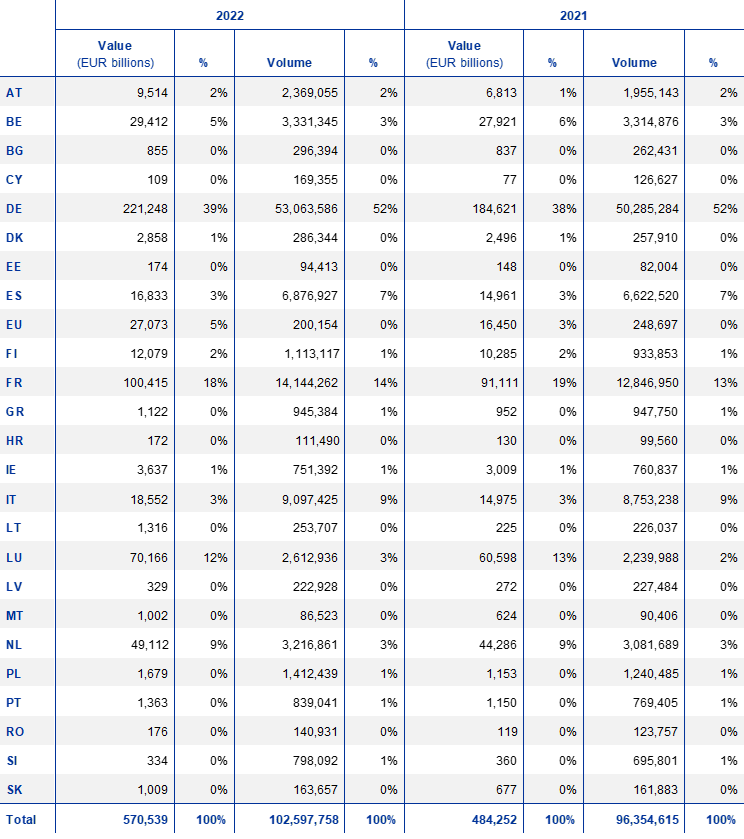
© European Central Bank, 2023
Postal address 60640 Frankfurt am Main, Germany
Telephone +49 69 1344 0
Website www.ecb.europa.eu
All rights reserved. Reproduction for educational and non-commercial purposes is permitted provided that the source is acknowledged.
For specific terminology please refer to the ECB glossary (available in English only).
PDF ISBN 978-92-899-5558-4, ISSN 1725-4884, doi:10.2866/359303, QB-AC-23-001-EN-N
HTML ISBN 978-92-899-5559-1, ISSN 1725-4884, doi:10.2866/88578, QB-AC-23-001-EN-Q
A payment is defined as the process by which cash, deposit claims or other monetary instruments are transferred between economic agents.
The Eurosystem fulfils this task by:
- providing payment and securities settlement facilities (TARGET2 (including TIPS) and TARGET2‑Securities (T2S)), as well as a mechanism for the cross-border use of collateral (the correspondent central banking model (CCBM));
- overseeing the euro payment and settlement systems;
- setting standards for the use of securities clearing and settlement systems;
- acting as a catalyst for change (e.g. facilitating the development of the Single Euro Payments Area (SEPA)).A real-time gross settlement (RTGS) system is a payment system in which processing and settlement take place in real time (i.e. continuously), rather than in batch-processing mode. It enables transactions to be settled with immediate finality. Gross settlement means that each transfer is settled individually, rather than on a net basis. TARGET and its successor TARGET2 were both RTGS systems.
For more information, see the ECB’s website: What is TARGET2-Securities (T2S)?
For more information, see the ECB’s website: What is TARGET Instant Payment Settlement (TIPS)?
See Monthly statistics of payment instructions processed by TARGET and EURO1/STEP1.
Together with the payments processed on T2S DCAs, overall turnover in 2022 reached €819.0 trillion, corresponding to a daily average of €3.5 trillion. More detailed information can be found on the ECB’s website: Value of transactions per month processed by TARGET and selected interbank funds transfer systems.
As a result of the migration of the central securities depositories (CSDs) to T2S, final settlement of the cash leg of securities transactions is no longer carried out on the RTGS accounts of their participants in TARGET2. Instead, it takes place via the DCAs held in T2S.
It should, however, be taken into account that, while the trends illustrated give an indication of the size of each system and the long-term pattern, they are also affected by fluctuations in the euro’s exchange rate vis-à-vis the US dollar and the Japanese yen, which may distort the figures. As both Fedwire Funds and CLS publish their turnover in US dollars, while the Bank of Japan uses Japanese yen, the turnover in euro is calculated on the basis of the ECB exchange rate for the last business day of the year in question.
In 2022 the average daily turnover of TARGET2 including transactions on T2S DCAs amounted to almost €3,500 billion, compared with about €2,800 billion in 2021.
With this major change for the industry, some participants reconsidered the routing policies for their customer payments and ultimately favoured channels other than TARGET2 (mainly SEPA-compliant ACHs), with some banks’ customers (mainly large corporate customers) specifically requesting this.
If the volume of transactions processed on T2S DCAs is included, this figure more than doubles, reaching 256 million. More details of the number of transactions settled on T2S DCAs, i.e. the cash leg of delivery-versus-payment transactions, can be found on the ECB’s website under: Monthly statistics of payment instructions processed by TARGET and EURO1/STEP1.
See paragraph 1.2 for an analysis of the yearly developments.
For more information on T2S, see T2S Annual Report 2022.
Overall liquidity is computed hourly.
From March 2023 onwards, with the go-live of the new T2 system, it is possible for participants to leave liquidity overnight on their T2S DCAs. The automatic cash sweep has therefore become optional.
The cash legs of security transactions are typically high-value operations.
As explained at the beginning of the chapter, the figures for night-time settlement do not include liquidity transfers between TARGET2 and TIPS/T2S.
For example banknote/coin withdrawals and deposits.
Regulation of the European Central Bank (EU) No 795/2014 of 3 July 2014 of 3 July 2014 on oversight requirements for systemically important payment systems (ECB/2014/28) and Regulation of the European Central Bank (EU) 2017/2094 of 3 November 2017 amending Regulation (EU) No 795/2014 (ECB/2017/32).
Those sanctions were issued as a reaction to the annexation of Crimea.
TARGET2 cash balances are used as a proxy for the amount of initial margin in euro posted by clearing members. Additional initial margin is posted to CCPs in non-cash high-quality liquid assets and/or other currencies.
For more information, see Frutos, J., Garcia-de-Andoain, C., Heider, F. and Papsdorf, P., “Stressed interbank markets: evidence from the European financial and sovereign debt crisis”, Working Paper Series, No 1925, ECB, Frankfurt am Main, June 2016.
For further information, see the box entitled “The usefulness of TARGET2 transaction data for the analysis of the unsecured overnight money market”, Economic Bulletin, Issue 6, ECB, 2015.
See Box 2 entitled “The TARGET2 Simulator”, TARGET Annual Report 2013, ECB, May 2014.
See Box 5 for further details.
Although it is acknowledged that the scope of the two datasets presents some differences, the relevance of the comparison between the money market activity based on TARGET2 and the MMSR framework was illustrated in the second public consultation on the publication by the ECB of an unsecured overnight rate in 2018, when the proposed alternative methodologies for the calculation of a new unsecured overnight rate to replace the EONIA were back tested on TARGET2 data.
For more information, see Frutos, J., Garcia-de-Andoain, C., Heider, F. and Papsdorf, P., “Stressed interbank markets: evidence from the European financial and sovereign debt crisis”, Working Paper Series , No 1925, ECB, Frankfurt am Main, June 2016.
The daily average activity of the MP that started on 22 December 2022 is not reported, as there were only six business days in 2022.
This figure covers InterAct messages received by the SSP in both U2A and A2A mode.
For further information, see Market Information Dissemination.
For further information, see Deloitte Report on the external review of TARGET Services in the context of the incidents in March, May, August, October and November 2020
For further information, see Action plan to address recommendations following incidents affecting TARGET Services in 2020
For further information, see AMI-Pay meeting documentation
For further information, see AMI-SeCo meeting documentation
An RTGS account for an internet-based participant also incurred additional monthly fees for the account itself and a flat rate fee of €0.80 per transaction.
With the go-live of the new T2 system, internet-based participation has not been available to participants since March 2023.
This figure represents the number of direct participants with at least one account in TARGET2. Direct participants may have had more than one account, which is why the figure is lower than the number of RTGS accounts reported in Section 3.1.
From a technical perspective, TARGET2 had 83 ancillary systems (one more than in 2021). However, this figure also includes, for example, central banks making use of the ASI to settle monetary policy operations. At the end of 2022 a total of 79 ancillary systems legally recognised as separate ancillary systems were using TARGET2 SSP for settlement purposes.
Ancillary systems not using the ASI alternatively held a regular RTGS settlement account and exchanged normal credit transfers with their settlement banks.
For further considerations on the public good factor, see “Public good issues in TARGET – Natural monopoly, scale economies, network effects and cost allocation”, Working Paper Series, No 505, ECB, Frankfurt am Main, July 2005, “Settlement finality as a public good in large-value payment systems” Working Paper Series, No 506, ECB, Frankfurt am Main, July 2005 and “Incorporating a “public good factor” into the pricing of large-value payment systems”, Working Paper Series, No 507, ECB, Frankfurt am Main, July 2005. A special study group analysed various issues relevant for the design of TARGET2. On completion of the group’s work, the ECB issued a series of published papers in its Working Paper Series.
This part corresponds to the initial development costs (i.e. Release 1.0). Only costs corresponding to the development of annual releases that had not yet been fully amortised (i.e. Release 2.0 and beyond) were still to be recovered.
In 2015 a new monthly fee was introduced for the DCAs linked to TARGET2 RTGS accounts and for the use of value-added services.
Option A (a monthly fee of €150 and a flat transaction fee of €0.80) was intended for small and medium-sized institutions submitting fewer than 8,625 TARGET2 transactions per month. For institutions making greater use, option B (a monthly fee of €1,875 and a degressive transaction fee of between €0.60 and €0.125) was proposed.
These are accounted for by core pricing participants, central banks using the ASI for “other purposes”, ancillary systems and liquidity pooling.
Some specific features of TARGET2 (e.g. liquidity pooling or multi-addressee access) offered the possibility of applying the degressive transaction fee to all payments initiated from accounts belonging to the same group.
See “The three lines of defense in effective risk management and control”, IIA Position Paper, Institute of Internal Auditors, January 2013.
Glowka, M. et al., “TARGET2 analytics tools for regulatory compliance”, Occasional Paper Series, no. 300, ECB, Frankfurt, August 2022.


